
Our recommendations
How we tested
We specialize in reviewing dental health products and we’ve been consistently testing them since Electric Teeth launched 8 years ago.
When a new brush is released, we buy it, test it and compare it to what’s already available. We then update our reviews and recommendations accordingly. We publish in-depth written and video reviews to share our findings and opinions.
We’ve included the most relevant details below, but we go into more depth in our detailed hands-on reviews. To make our recommendations, we test and consider the features that dentists recommend as the most important: a pressure sensor, timer and pacer.
But we also take into account the finer details like how easy it is to keep a brush clean, how difficult the heads are to pull on and off, and whether or not it’s easy to accidentally turn the brush off during use. You can find out more about our testing process here. Not only do we test products ourselves, but we take on feedback from our community. We have open comment sections and a popular YouTube channel.
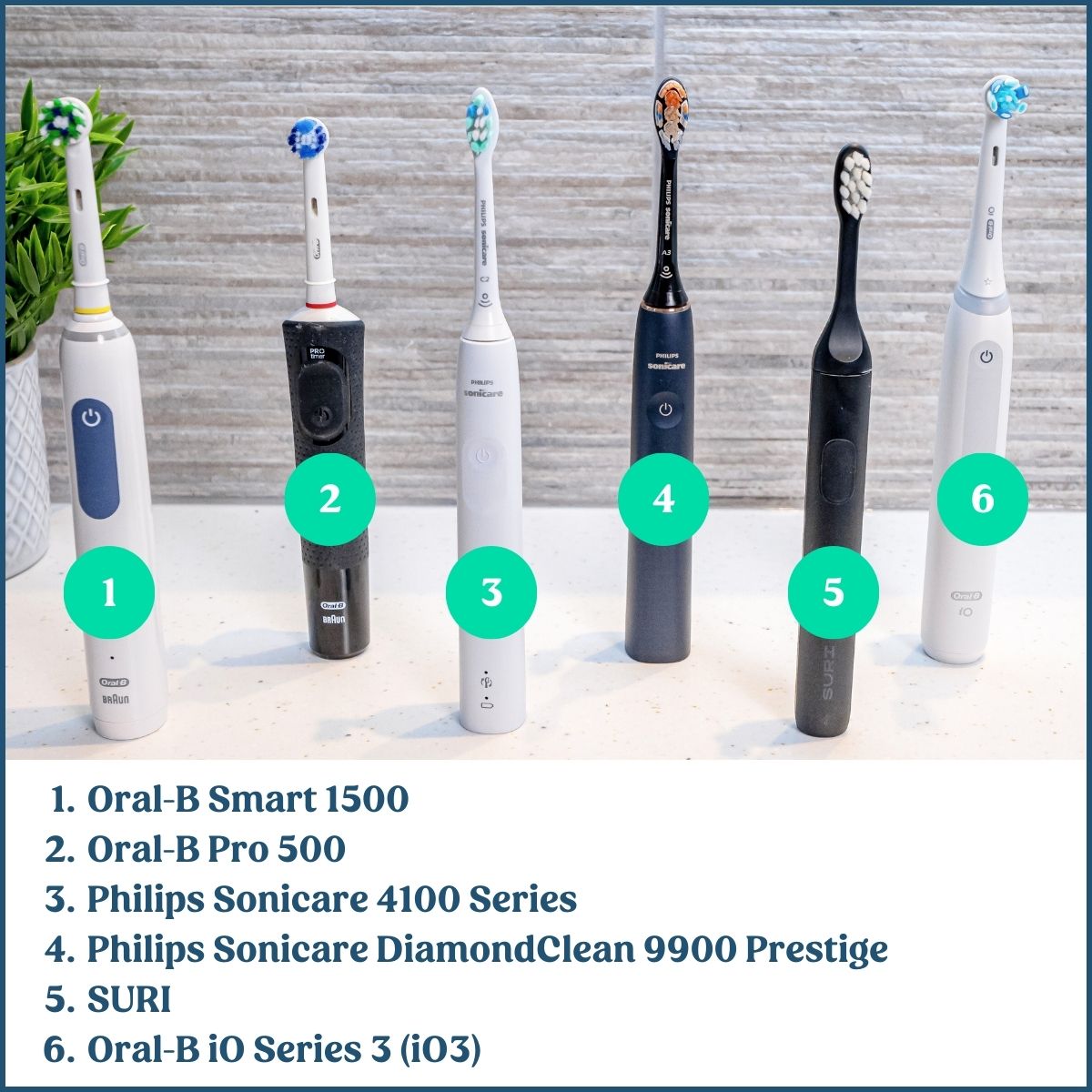
What to look for, what to avoid
We explain these points in more detail later on, but before you make a choice, here are the key things you should know to avoid spending too much or too little.
Keep these in mind as you browse our recommendations below and keep reading for more insights from our testing:
Best overall
The Oral-B Smart 1500 and the Oral-B iO3 are what we regard as the best brushes for the majority of users. They've got the key features, but don't inflate the price with unnecessary extras.
Oral-B Smart 1500

Cleaning modes: 3 | Battery life: 14+ days | Bluetooth: No | Noise: 75dB | Head cost: $5| Cost to own - 3 yrs: $120
Who it's for:
Someone who wants a reliable brush with dentist-recommended features (a timer, a pacer and a pressure sensor) for a fair price.
Why it's our main choice:
It has the essential features you need and not lots of unnecessary extras. Replacement brush heads are affordable, too.
We loved the cleaning results the Smart 1500 gives. After each brushing session, our teeth felt like they had just had a scale and polish at the dentist.
More on why we chose it...
We’ve found that because the toothbrush doesn’t turn off automatically, we often brush for a bit longer than the recommended 2 minutes.
Having tested many brushes, we know that all will, over time, be left with toothpaste residue and gunk on the head and handle. The Smart 1500 is one of the easiest brushes to keep clean — a quick rinse or wipe is all you need. The lack of rubber grips helps here, but the downside is that it’s not as grippy as some other handles, particularly when wet. Unless you struggle to hold things this isn't a problem.
We like the fact the 1500 offers a sensitive cleaning mode. We didn’t always need it, but for those times we did, it was a delight. It’s also a great mode for easing yourself into the increased power of an electric brush.
It’s slightly annoying that there are no labels on the handle to show which mode you have selected. It always defaults to Daily Clean. If you want the sensitive mode you need to press the power button twice, every time you use it.
At 75 decibels it's one of the louder brushes we’ve tested, although typical for Oral-B. If you’re brushing whilst someone sleeps, you’ll want to shut the door. The vast majority of brushes operate at 60-70dB. Unless you need a very quiet brush (see our recommendations below), this isn’t a big issue.
Despite being called ‘Smart 1500’ there is no Bluetooth connectivity, and therefore is not a ‘smart’ toothbrush as the name may suggest.
Read our Oral-B Smart 1500 Review.
What we like |
Worth noting |
|---|---|

Easy to keep clean |
No cleaning mode icons/labels |

Small round brush head cleans the teeth well |
Defaults to the daily clean mode |

Dentist recommended features |
Despite the name, it is not a ‘smart’ toothbrush |
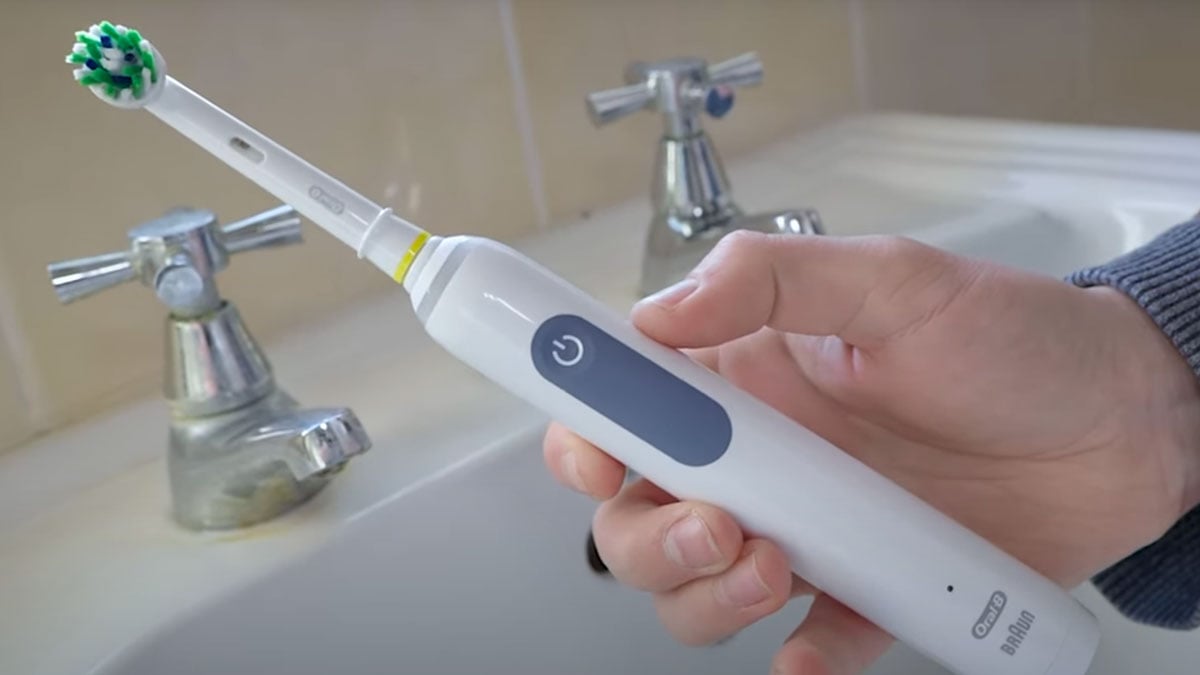
Runner up
Oral-B iO3

Cleaning modes: 3 | Battery life: 14 days | Bluetooth: No | Noise: 64dB | Head cost: $12 | Cost to own - 3 yrs: $202
Who it's for:
Someone who wants a good value brush with an advanced pressure sensor
Why we picked it:
It offers a quieter and softer brushing experience than the Smart 1500. The pressure sensor is also more useful.
The iO3 is similar to the Smart 1500 and is often cheaper, but its replacement brush heads are twice as expensive, making it more costly long term. Both are great, but the Smart 1500 is better value for money.
More on why we recommend it...
Exclusive to the iO Series is an advanced pressure sensor. We particularly like how it shows with a green light when you’re applying the correct pressure, rather than just showing a red LED when you brush too hard. The iO is the only range that has a pressure sensor like this.
Whilst we don’t quite agree, we understand the sentiment when readers say the Smart 1500 feels like a jackhammer in the mouth. The iO3 feels quite a bit different in that respect; it’s far less aggressive and we found it noticeably softer on the teeth when brushing. If you’ve got gum recession or tooth sensitivity, the iO3 is a good choice.
It’s noticeable how much quieter the iO3 is compared to the Smart 1500 — 64 decibels compared to 78. It’s less mechanical sounding, which is more pleasant. The matt finish to the iO3 handle creates a smarter looking brush than the gloss plastic found on many other Oral-B models.
Letting the iO range down is the cost of replacement brush heads. Although the iO3 is the cheapest model in the range, it still requires iO-specific refills. These are around 2 times the cost of those for non-iO brushes like the Smart 1500. We do prefer the feel of iO brush heads, but if you’re on a budget the difference isn’t worth stretching for.
Read our Oral-B iO3 Review.
What we like |
Worth noting |
|---|---|

Premium looking handle that is easy to keep clean |
No icons on the handle to show which cleaning mode is selected |

Quieter than other Oral-B brushes |
Requires iO specific heads which are more expensive |

Reminds you when to replace the brush head |
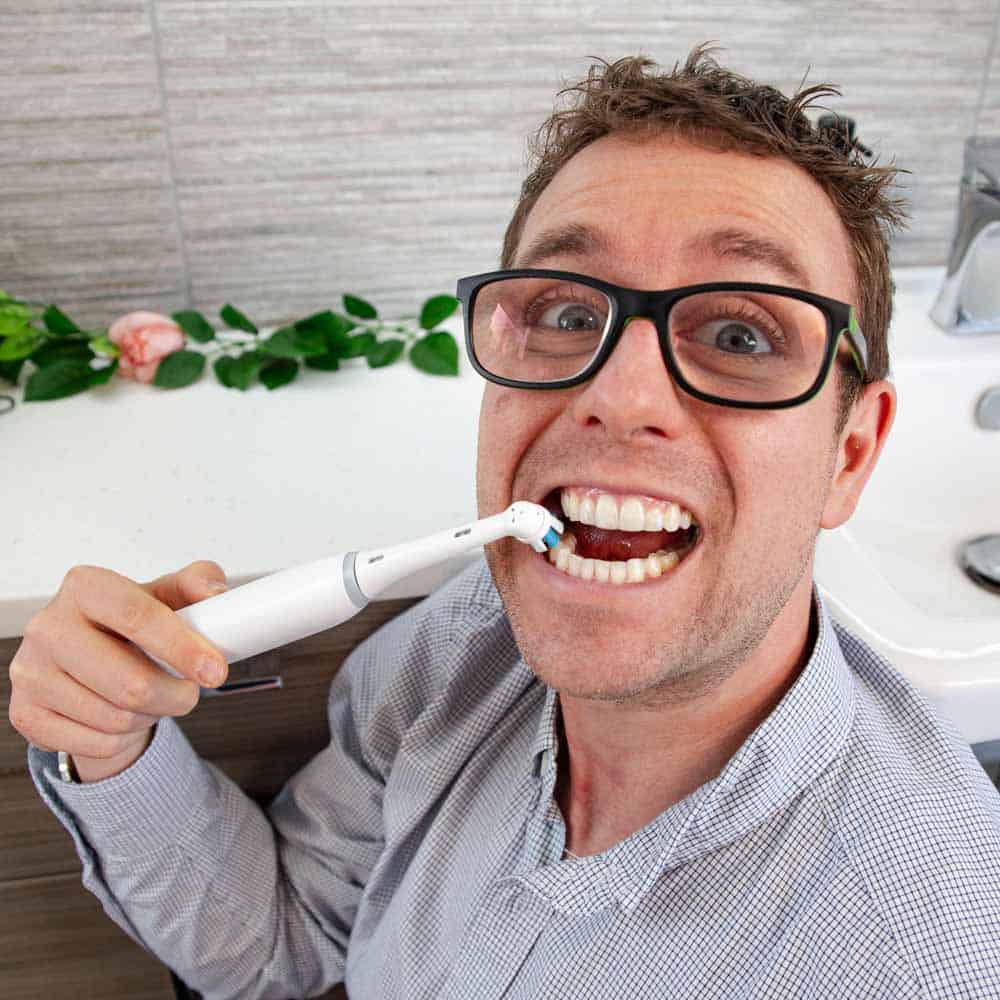
Most environmentally-considerate
SURI
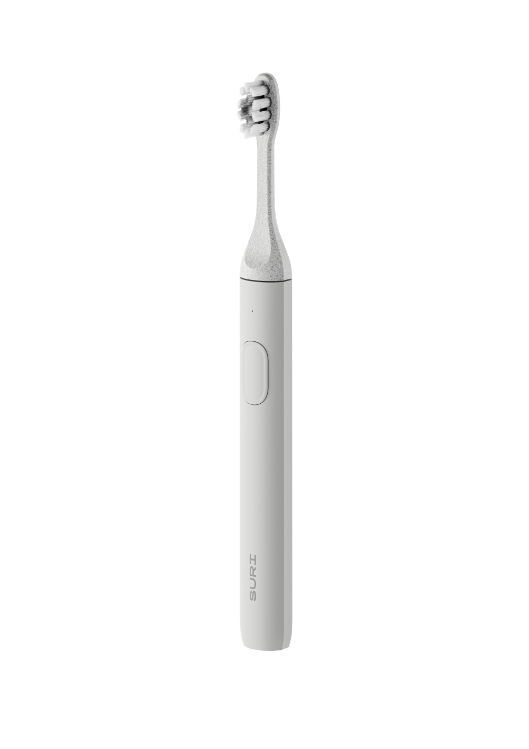
Cleaning modes: 2 | Battery life: 40 days | Bluetooth: No | Noise: 54dB | Head cost: $6 | Cost to own - 3 yrs: $168
Who it's for:
Someone who’s willing to pay a bit more for a good quality brush that considers the planet
Why we like it:
Our team has been thoroughly impressed by the quality, travel-friendly design, cleaning results and company ethos of SURI — several have made it their daily toothbrush since its original testing in 2022.
More on why it's good...
Unlike most other brushes SURI’s handle is made of metal, which gives it a premium look and feel. We find its weight and shape balance nicely in our hands and give it a solid, well-built quality.
It’s a brush that’s easy to keep clean and doesn’t need charging regularly. We’ve found the cleaning results to be just as good as brushes from major brands.
SURI has made simple design choices that work. The compact travel case feels sturdy and allows the brush to charge in the case. We’ve also enjoyed reduced clutter in the bathroom thanks to the effortlessly simple magnetic wall mount.
The main downside is that SURI doesn’t come with a pressure sensor. As experienced toothbrush users, this wasn’t a problem for us. But if you’re a first time toothbrush user or if you know you brush too hard, this may not be the brush for you.
The brush heads can also be a bit stiff to pull off, which you need to do every so often to rinse the brush thoroughly. This is only likely to be a problem if you’ve got dexterity issues or have trouble gripping things tightly.
For many, the main appeal of SURI will be its better focus on environmental impact than its competitors. It’s designed to be easily repaired, albeit by SURI rather than the user. This is commendable and something we look at more closely in our SURI review.
What we like |
Worth noting |
|---|---|

Environmentally considerate materials and design |
No pressure sensor to alert you when brushing too hard |

Slim handle |
1 year warranty |

The timer and pacer encourage brushing for the recommended time |
USB charger makes it less convenient for some |
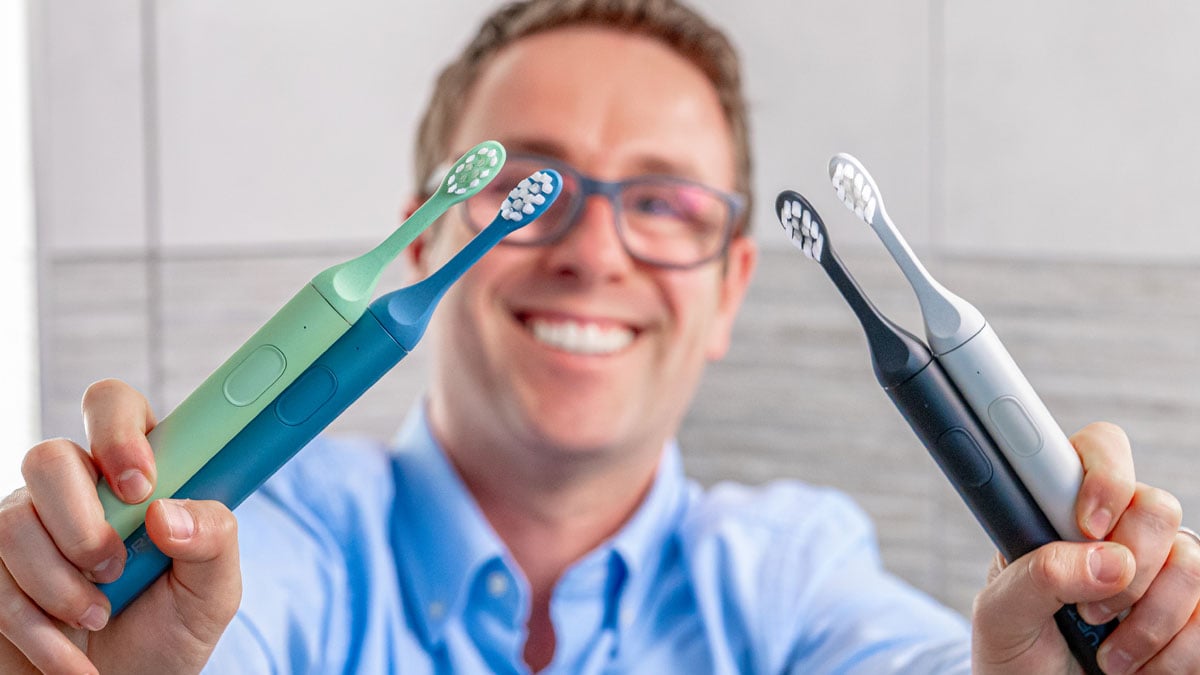
Best technology
Sonicare 9900 Prestige

Cleaning modes: 5 | Battery life: 14 days | Bluetooth: Yes | Noise: 71dB | Head cost: $10 | Cost to own - 3 yrs: $430
Who it's for:
Someone who wants the very best and doesn’t mind paying for it.
A fantastic brush, but more than you need:
We love how it looks, how it feels and how it performs. It has certain refinements and extras that you don’t get with more affordable models. It’s the best smart toothbrush we’ve used.
More on why we chose it...
The smooth touch materials are good quality and we found it easy to keep clean.
To address past reliability issues, Philips has implemented a seamless power button design. The intention of this is to reduce grime build up and, from our testing, this seems to have worked. It does mean that the feedback isn’t as tactile — it’s a bit firm — but this wasn’t a big issue for us overall.
To some it might feel a bit overbearing, but the Sonicare app and tracking technology can improve your oral care routine. It shows and logs where you have and haven’t brushed, which really helps if you like to learn visually. It tells you if you’re brushing too hard and it even monitors, alerts and adapts if you move the brush head too much.
During our testing, we didn’t find the smart features to be annoying, but we stopped checking the app for feedback after a while, which defeats the point of having a premium smart brush. Unless you’re dedicated enough to spend the time using it, it’s not worth paying for the extra tech.
Something we did find frustrating was having to use the app to change cleaning mode. Unlike other toothbrushes, you can’t do it using the handle itself. Then again, the extra modes have little benefit in our experience.
The compact USB-C enabled charging case feels robust and we’ve enjoyed its smaller-than-average profile when travelling. The strap on the case is a little impractical — it’s too tight to go over most hands and onto the wrist — but it’s a minor complaint in the scheme of things.
Read our Sonicare 9900 Prestige review.
What we like |
Worth noting |
|---|---|

Premium look & feel |
Expensive |

Visible pressure sensor alerts you when brushing too hard |
No place to store the detachable USB cable |

Reminds you when to replace your brush head |
Pressure sensitive buttons |

Stylish & compact charging travel case |
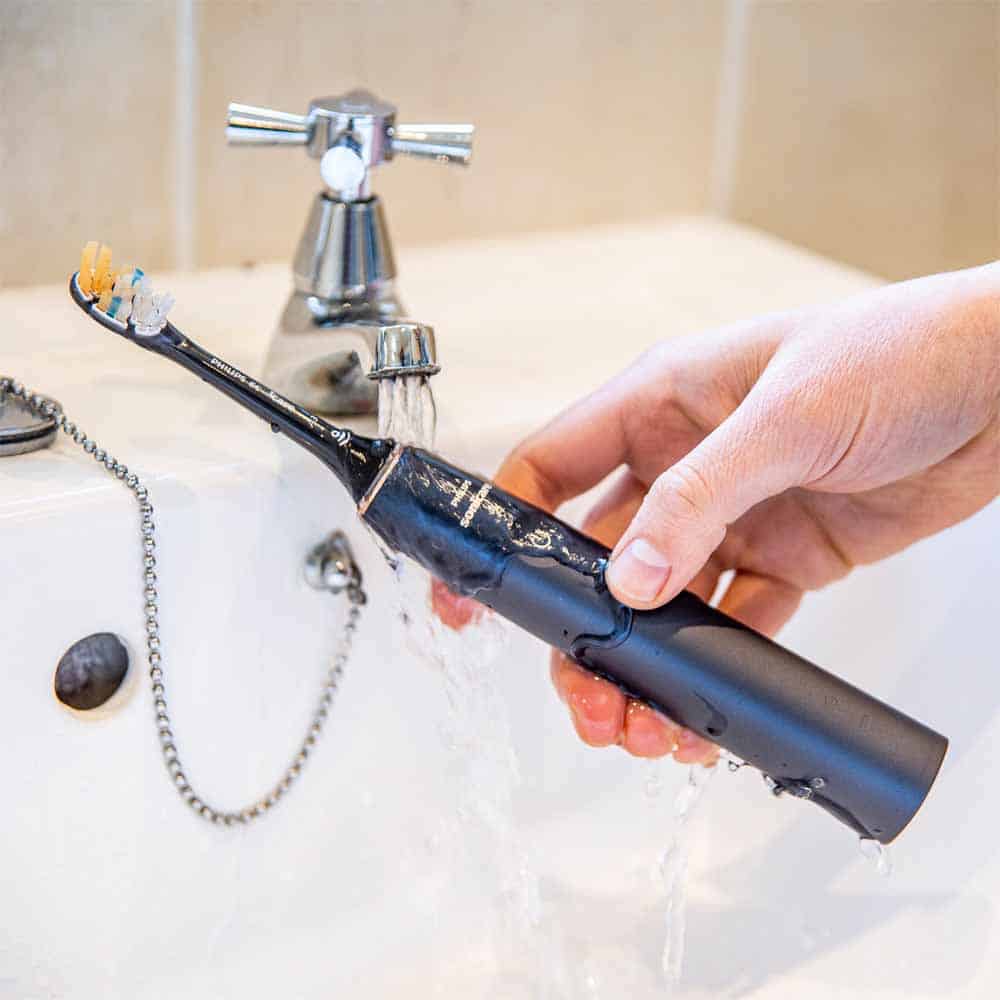
Best for sensitivity
Sonicare 4100 Series

Cleaning modes: 1 | Battery life: 14 days | Bluetooth: No | Noise: 60dB | Head cost: $10 | Cost to own - 3 yrs: $150
Who it's for:
Those who want a gentle but effective clean. See the advice in this section if you've got receding gums or sensitive teeth.
Why it's good for sensitive teeth and gums:
We like the slim profile, the less intense brushing sensation and the opportunity to buy it with a travel case.
The Sonicare 4100 is the Philips equivalent of the Oral-B Smart 1500. It’s a slim and quiet brush with good cleaning results at an affordable price.
More on why we chose it...
The 4100 Series offers a low and high power setting. Both intensities feel less harsh on the teeth and gums than the oscillating-rotating action of Oral-B models. Importantly, we haven’t found this to have a negative impact on cleaning results.
A Clinical study has found evidence that Sonicare’s sonic cleaning action can deliver better results long term than an Oral-B brush, particularly for more advanced gum disease.
If your sensitivity was caused by brushing too hard, the pressure sensor in the 4100 will alert you if you fall back into old habits. It is configured differently to Oral-B brushes — the handle vibrates rather than activating a light. It’s more noticeable and more useful if you are blind or partially sighted.
The fact that the 4100 alerts you when it's time to replace the brush head is quite handy. We didn't find the notification to be too annoying and you’re not prevented from using the head for longer if you want to.
When you do replace it, the 4100 detects the new head automatically. There’s no need to reset the tracking facility, like there is with app-based brush head trackers on some other brushes. It’s an effortless process. The only thing we don’t like is that more e-waste is created each time you use a head.
We couldn’t help but notice how much quieter the 4100 is than the Smart 1500, which is the equivalent brush from Oral-B. We could hear music clearly or hear someone talking. The same can't be said for the 1500.
One annoyance might be the USB charging stand. It has a USB connection and doesn’t come with a 2 pin USB power adapter. You can likely make use of one that comes with your smartphone or other electronic devices, though.
Read our Sonicare 4100 Series review.
What we like |
Worth noting |
|---|---|

Slim, stylish & easy to keep clean |
No indicator lights to show which intensity is selected |

2 intensity settings – choose between low and high power |
USB charger makes it less convenient for some |

Reminds you when to replace your brush head |
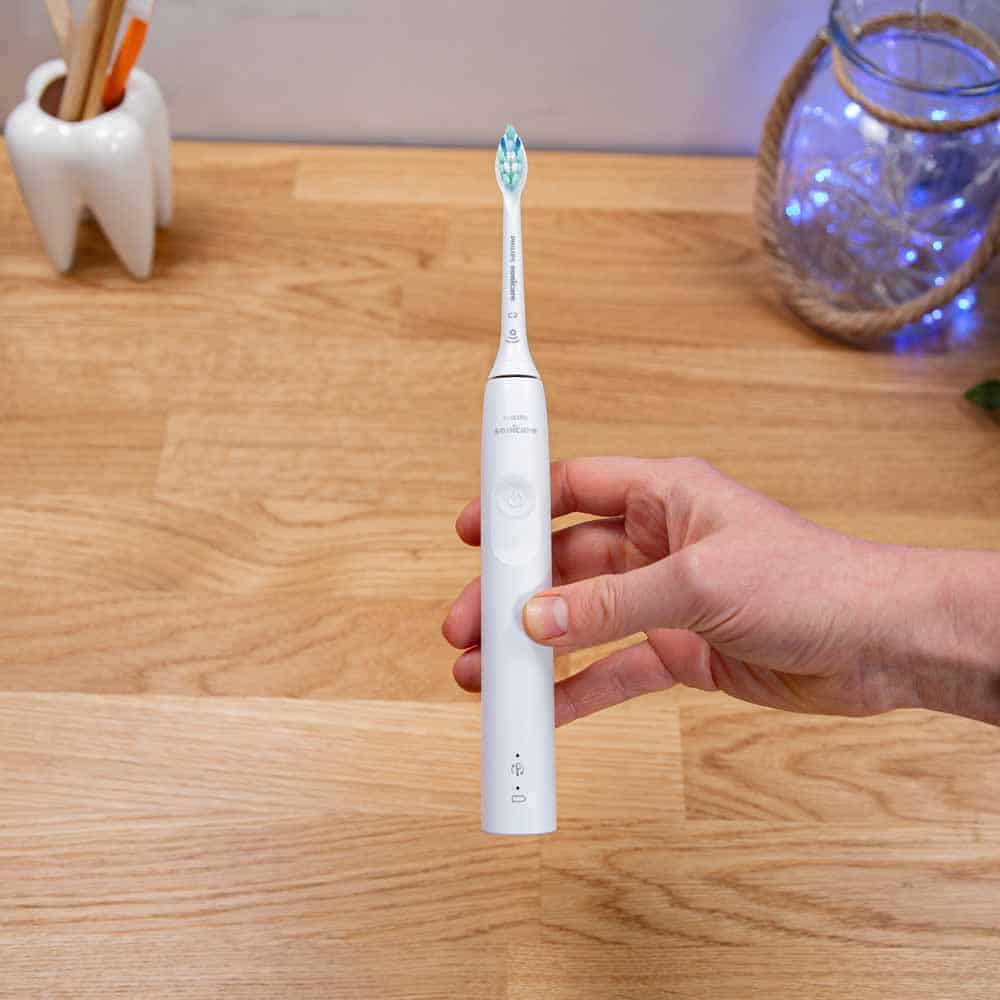
Best budget
Oral-B Pro 500

Cleaning modes: 3 | Battery life: 10 days | Bluetooth: No | Noise: 73dB | Head cost: $5 | Cost to own - 3 yrs: $85
Who it's for:
Someone who wants a reliable brush for as little money as possible. If that's you, see our advice below on choosing a budget brush.
Cheap, but still reliable:
We love that for a fair price you get a really grippy handle that delivers perfectly adequate cleaning results. Impressively, the Pro 500 doesn’t look or feel cheap — the reduced cost comes from excluding some features.
More on why we chose it...
The Pro 500 would suit a lot of different users, but from our testing, those with arthritis or dexterity issues come to mind in particular. The large rubber grip wraps around the whole handle and doesn't feel slippery, even when wet. The tapered design is a bit thicker than most brush handles, which helps if you can’t form a tight grip.
A slight negative is that toothpaste residue and grime can collect on the dimpled surface, but it’s a worthwhile tradeoff. The 500 does not include a pressure sensor, but that is understandable at this price point.
Another downside is that there is nothing to indicate battery status. The Pro 500 has one of the shortest usage times of a rechargeable toothbrush, so it would be useful to get a warning when it needs a top-up. Unless you charge it after most brushing sessions, there is a good chance of it power off mid brushing. Depending on the convenience of your charging set up, this is a worthwhile trade off for the cost saving.
Read our Oral-B Pro 500 review.
What we like |
Worth noting |
|---|---|

Simple to use – 1 cleaning mode |
No pressure sensor |

The grip on the handle helps to securely hold the brush |
No battery status feedback |

The small round brush head reaches tighter spaces |

Best for travel
Philips One by Sonicare

Cleaning modes: 1 | Battery life: 30 days | Bluetooth: No | Noise: 71dB | Head cost: $5 | Cost to own - 3 yrs: $95
Who it's for:
Those looking to travel extremely light, particularly backpackers.
Why it impressed us:
It’s not much bigger than a manual toothbrush and comes with a useful travel case whilst giving a little extra cleaning power.
More on why we chose it...
You will barely notice this toothbrush in your bag. You could even slip it in your pocket if you so desired.
We prefer the rechargeable variant over the AA battery option — you get the same good battery life, but you also get feedback on the remaining power via an LED.
Because it uses a USB Type-C connector, you can probably use the same cable to charge your phone and your brush.
The One is a crossover between a manual and electric brush and we did find the cleaning action to be a bit weak as a result, but we found that plaque removal was still good if we made sure to use the correct technique. It doesn’t feel as thorough as other electric toothbrushes, but that’s the trade off for a slim, lightweight brush. If you’re looking to use it as your main brush, you may be disappointed if you’ve had a more powerful brush in the past.
The travel case has been designed to be as small as possible, but we found that it still offers adequate protection of the bristles and power button.
Read our Philips One review.
What we like |
Worth noting |
|---|---|

Slim, light and grippy in hand |
The cleaning power is a little weak |

A travel case is included |
No pressure sensor |
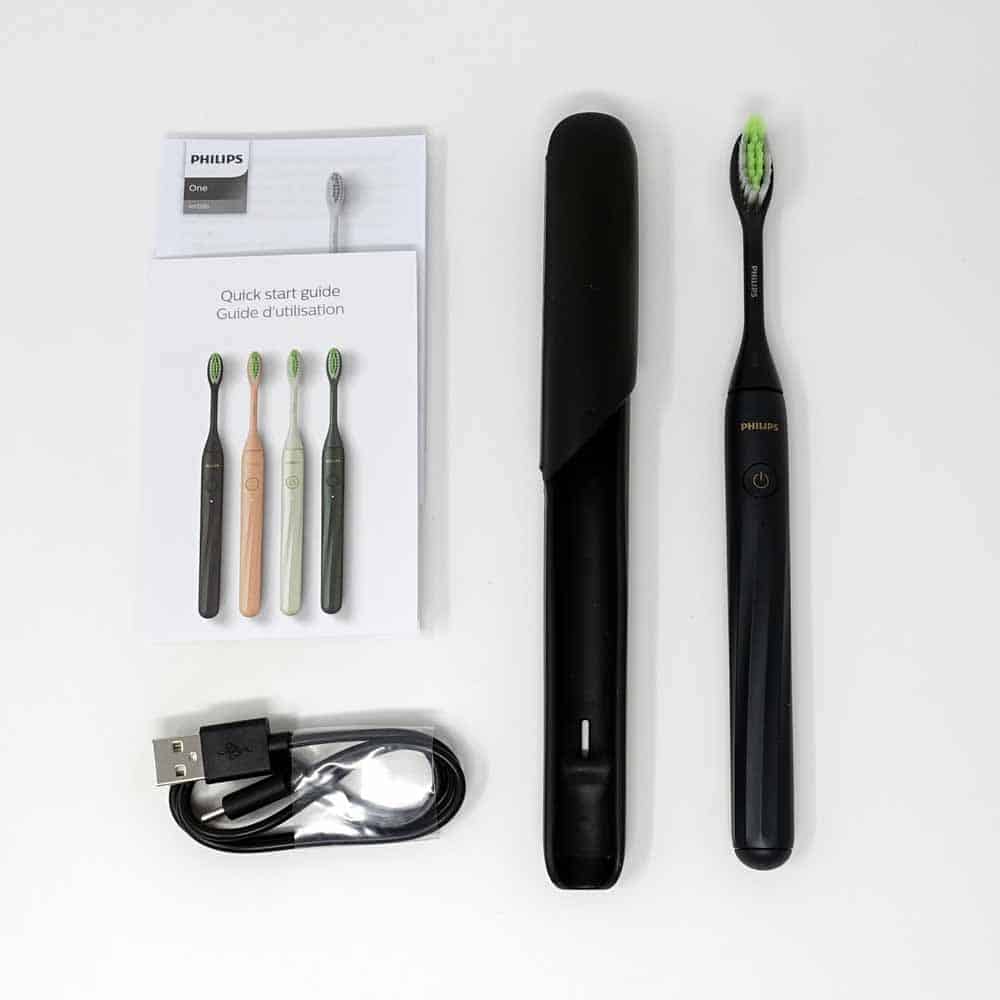
Quietest
Oclean X Pro Elite

Cleaning modes: 4 | Battery life: 35 days | Bluetooth: Yes | Noise: 45dB | Head cost: $7 | Cost to own - 3 yrs: $157
Who it's for:
Those who want an almost silent tooth brushing experience.
Quiet, without compromise:
It’s the quietest brush we’ve tested and makes no compromises to achieve it.
More on why we chose it...
The X Pro Elite doesn’t look or perform differently to any other regular electric toothbrush, yet it is 15-25 decibels quieter than bigger brands like Oral-B and Sonicare.
You do pay a slight premium, but it’s well within the lower mid-tier price range and you actually get valuable extras.
The X Pro Elite comes with 4 cleaning modes and 32 different intensity settings, which is overkill in our experience. We tended to use it on the maximum setting, which was comparable to Sonicare. We can’t imagine a need for such granular control over intensity, but if you suffer from sensitivity it might be useful.
A timer and pacer are included. There is a pressure sensor, but it’s not visual, nor does it vibrate. It does slow the motor to limit the damage though. We didn’t find it to be as good as pressure sensors from Oral-B and Sonicare, but if you want the quietest brush possible, it’s something that can be overlooked.
If you have a small bathroom and limited countertop space the magnetic wall mount really helps. 1 month of usable battery life meant that we only needed to get the USB charging stand out once a month during testing. It doesn’t need a permanent home on the worktop.
We liked how it tracks in real-time to give feedback on brushing via the touchscreen display. It’s far from perfect, but better than nothing. It’s great to get this without a silly price hike to pay for it.
Read our Oclean X Pro Elite review.
What we like |
Worth noting |
|---|---|

Stylish handle with color touchscreen display |
Bluetooth & smartphone app – Doesn’t work in real-time |

The grip on the handle helps to securely hold the brush |
Can’t be charged whilst mounted on the wall holder |

Easy to use magnetic wall mounted holder |
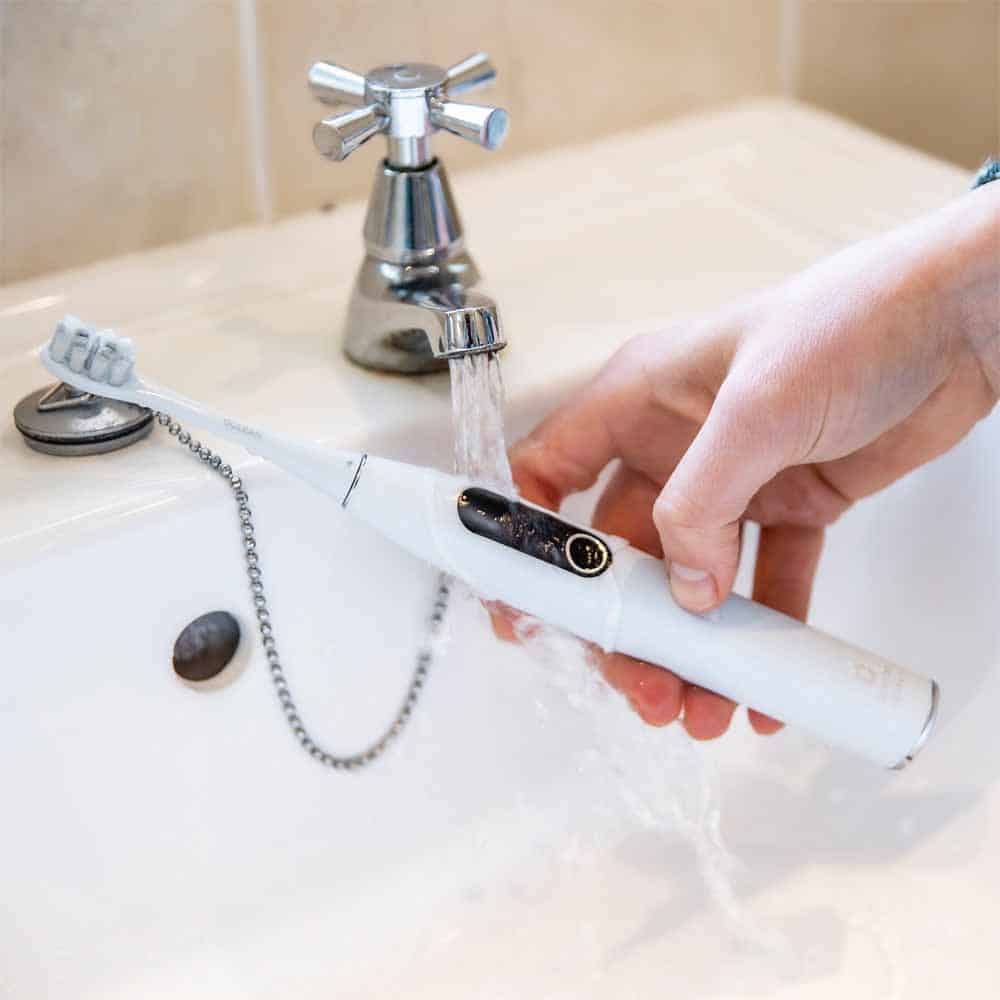
Best removable battery
Oral-B Pro 100

Cleaning modes: 1 | Battery life: 90 days | Bluetooth: No | Noise: 71dB | Head cost: $5 | Cost to own - 3 yrs: $70
Who it's for:
Someone who doesn’t want to plug their toothbrush in to recharge.
Why we picked it:
It gives 3+ months of battery life, it’s grippy, easy to use and affordable.
More on why we chose it...
You can’t fault the ease of use of the Pro 100. It’s one of the most textured and grippy handles we’ve used. It’s got a shorter and wider profile than most brushes.
We found cleaning results to be perfectly adequate. You can get better results from other brushes, but as long as you use it correctly it’s not a night and day difference.
We enjoyed the simplicity of only having 1 cleaning mode to choose from. Other than a sensitive mode, the additional cleaning modes that other brushes have aren’t really necessary.
Given it costs less than a week's worth of coffee, it lacks all the other bells and whistles of other electric brushes.
It’s a cheap long term option because it uses Oral-B’s standard brush heads which are half the price of iO heads or those from other brands.
Replacing the 2 x AA batteries can add to the ownership cost, but you do have the option of using rechargeable AA’s. Replacing them can be quite tricky — the cap doesn’t glide on and off as well as we would like — but a quick fix is a bit of oil on the rubber o-ring.
Watch our Oral-B Pro 100 review.
What we like |
Worth noting |
|---|---|

1 cleaning mode that’s easy to use |
No timer, pacer or pressure sensor |

The grip on the handle helps to securely hold the brush |
No battery status feedback |
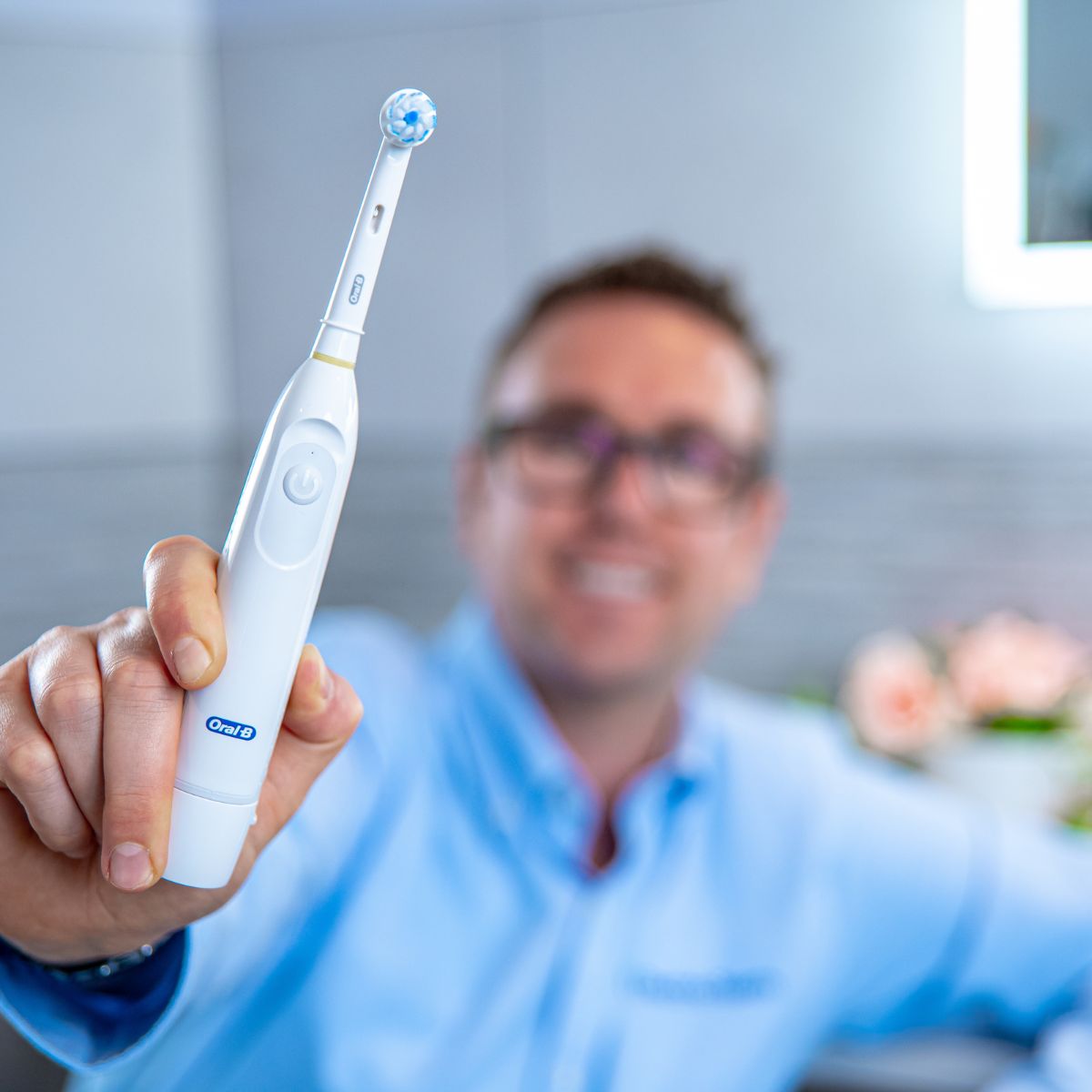
Notable mentions
These are products that didn't quite make it into our list above, but have features that may find useful in specific cases.
Oral-B Pro 1000
It sits between our best overall and best budget recommendations.
You’ll get better cleaning results than the budget Pro 500, but you don’t get the visible pressure sensor of the Smart 1500.
If you know you don’t brush too hard this is an excellent choice. It strikes a balance between features and price.
Read our Oral-B Pro 1000 review.

Hum Smart Rhythm
We like how you can earn points for completing your twice daily brushing. Those points can be converted into cash to cover the cost of replacement heads, to keep ownership costs down.
Exceptional value for money for what you are getting, you’re not paying a premium for smart tech. The fact it’s powered by AA batteries and comes with a travel case makes it a great option for travelers.

Oral-B Smart Clean 360
This is an exceptionally good value package if you need 2 toothbrushes. It’s a great option for couples, families, or even friends. It’s cheaper than buying 2 brushes separately and you get a travel case and charging stand for each brush
The brush is slightly different from our top recommended Smart 1500. You get more brushing modes and it cleans the teeth just as well.
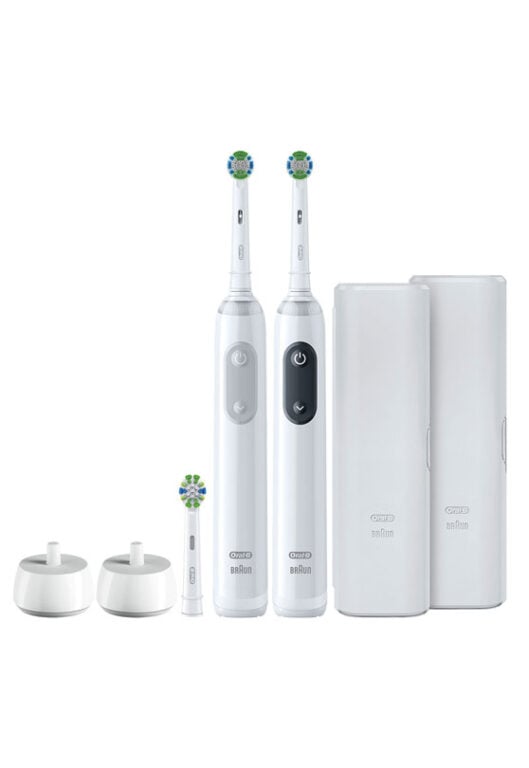
Curaprox Hydrosonic Pro
The small teardrop brush heads with soft bristles are an absolute delight to use. We found it much easier to reach the tighter spaces in the mouth with these heads compared to most other sonic brushes. The silicone backed heads helped to prevent that cold and harsher feel on the teeth and gums.
The handle is unique in that it has flat sides and we noticed how it encouraged us to tilt the brush at the correct angle.
It looks and feels great, but is a bit pricey given the other choices available.

Recently tested
We like to get our hands on the newest toothbrushes and test them to ensure that our recommendations are relevant and up to date.
The Laifen Wave is the newest and most interesting product we've tested. It's gained a lot of media attention and for good reason. It is an impressive brush all things considered. The cleaning results are superb and it boasts an easy to use magnetic charger and innovative button lock for travel.
Frustratingly, the important 30 second pacer is disabled by default. You have to download an app to enable it. That app gives further customization of the cleaning modes, but we're not sure the app is necessary.
Our full video review of the Wave goes into more detail and highlights how heavy the fingerprint magnet stainless steel version is.

The Apple Mac like magnetic charging cable is effortless to use (top right)
The stainless steel variant is heavy, reflective and picks up fingerprints (bottom right)
The Burst Curve Sonic is geared to be a travel friendly option and has a button lock like the Wave. It's pretty light and comes with a decent travel cap for the brush. The plaque removal results from the soft tapered bristles are impressive. Unfortunately the battery life isn't that great when using the more powerful and invigorating whitening mode. We haven't been able to get anywhere near the advertised 75 days!
We are finalizing our testing of the Oclean X Ultra S. A new top of the line brush, it offers a couple of enhancements over the X Pro Digital. The differences are minimal as is the price. We think it's worth the upgrade given the presence of a visible pressure sensor and innovative bone conduction audible warnings of common brushing problems like brushing too fast and hard. We are big fans of the USB type c enabled travel case and the sheer value for money it delivers.
Chinese brand Bitvae has added the R1 to its range. This is a slightly cheaper model, at $20 compared to the $25 of the R2 we tested recently. It lacks a visible pressure sensor and doesn't come with a travel case, but is one of the few models to embrace the oscillating and rotating brushing technology similar to Oral-B. Our R1 vs R2 comparison video shows these differences if you are interested.
It's likely going to be a few months before we can give our final verdict, but we excitedly await a new iO model. Oral-B has recently announced the iO Series 2. This is the cheapest model yet and is aimed at first time electric toothbrush users. It has many of the things we love about the iO range, but the lack of a visible pressure sensor is disappointing but helps bring the overall cost down.
Buyer's guide: useful tips from years of toothbrush testing
In the following sections we've included things we've picked up from reviewing the full spectrum of electric toothbrushes over the last decade.
We cover the features we think are the most important to pay for, as well as others that are worth considering but not critical for the majority of users. We also give some advice on how much to spend.
Key considerations
A pressure sensor, a timer and a pacer are the features worth paying for
These three features help to make sure you brush correctly and for the right amount of time. Generally, you can get a good brush with these features for around $50-80. They are particularly useful if you're a first time toothbrush user, or if you know you brush your teeth too hard.
We have a post that looks at electric toothbrushes with pressure sensors in more detail, but below we have included an overview of why they're important, and here are our main recommendations at a glance:
Good value for money, visible pressure sensor: Oral-B Smart 1500 / Amazon, Oral B / ~$73.99
Most advanced pressure sensor: iO range (iO3 is the cheapest) / Amazon, Oral B / ~$79.97
Good value for money, vibrating pressure sensor: Sonicare 4100 Series / Amazon, Philips / ~$49.49
How pressure sensors vary (and why they’re important)
Brushing too hard can damage your teeth and gums. A pressure sensor helps prevent this. Consequently, it's a key feature recommended by our in-house dentists.
If you know that you brush too hard, or if you’ve never used a toothbrush with a pressure sensor, it’s a feature worth strong consideration.
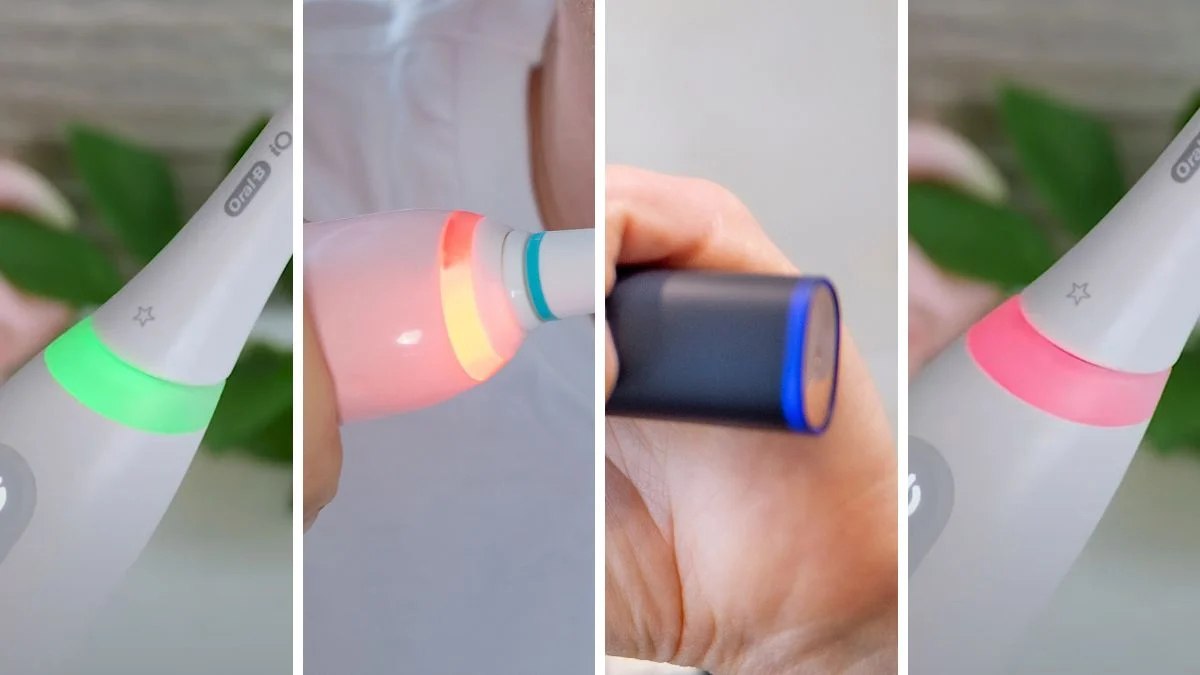
Keep reading
Sensors are implemented differently. In many instances when pressure is detected, the motor will slow down until the pressure is relieved. This limits the bristle movement and potential damage.
A visible pressure sensor will illuminate to act as a visual alert. This is common in Oral-B brushes. Normally, a red light illuminates around the neck of the toothbrush.
Some models, notably Sonicare, will vibrate the brush handle to alert you.
If you tend to brush your teeth in front of a mirror, you will likely find the visible pressure sensor (one that lights up when you apply too much pressure) easier to take note of.
However, if you tend to get a bit distracted as you brush, don’t brush in front of a mirror or are visually impaired, the beeping or vibration patterns generated by some pressure sensors (notably Sonicare) are better.
With the exception of the Sonicare DiamondClean 9900 Prestige, most brushes do one or the other, not both.
The Oral-B iO range features a more advanced pressure sensor. It indicates when you’re brushing too hard, but also when you are applying the correct or insufficient amount of pressure. We did find this to be reassuring, but it’s something you could skip if you’re on a tight budget. The main thing is that you don’t brush too hard.
Most brushes have a timer and a pacer
For 2 minutes twice a day is how long you should spend brushing your teeth according to the likes of the American Dental Association and World Dental Federation. It’s the optimum time for effective plaque removal.
A timer lets you know when you’ve brushed for this long, whilst a pacer encourages even brushing of the teeth.
All of the brushes we've recommended above have a timer and pacer included. The only exceptions are the Pro Battery which has no timer or pacer, and the Vitality which has a timer but no pacer.
These are features that are really useful and we've found that the way they work tends not to vary much from one product to another. Don’t worry too much about these when choosing a brush. The main thing is to make sure your brush does include them, if your budget can stretch that far. There can be some nuance to them, which we explain in the toggle sections below.
Find out more about timers
The vast majority of brushes automatically turn off after 2 minutes. This might be annoying if you're someone who likes to brush for longer than that.
Oral-B brushes don’t tend to turn off, that’s for you to do when you’re ready to finish brushing. It will pause briefly 3 times at 2 minutes to alert you that the recommended time has been achieved.
Find out more about pacers
Most pacers work by pausing the brush motor at 30 second intervals. The pause in the sound and motion of the toothbrush is your cue to move from one quadrant of the mouth to another. Some brushes (notably Sonicare) have a pacer set to 20 second intervals. This results in 6 sections of the mouth for you to brush.
We've tested hundreds of different brushes over the years and we've never found the implementation of the pacer to make that much difference to how well we brush.
The bottom line is that a pacer is useful to have, especially as you develop your own rhythm to brushing with an electric toothbrush, but precisely how the pacer is implemented doesn't matter too much.
We’ve heard from some users how they dislike a pacer and prefer to brush at their own pace. Unfortunately, few brushes allow the pacer to be disabled. Some brushes, normally the ‘smart’ ones such as the Oral-B iO and Genius models, offer some customization around timings.
Some brushes are easier than others to keep clean
It’s important to keep your brush clean. The last thing you want is to be putting unwanted bacteria into your mouth.
We’ve found that a quick rinse after each brushing session and then leaving the brush to air dry is typically the best approach. UV lights and sterilizing processes can help but are not essential or as recommended as you might think.
During our long-term testing of brushes, we have found that grime can build up more easily on some than on others — we've included some examples in the next section. If you’re often in a rush when you brush your teeth, it’s a good idea to have a brush that’s simple to clean.
From those we’ve recommended above, the easiest to keep clean are: Oral-B Smart 1500, SURI, Sonicare 4100, 4100, 9900 Prestige and Philips One.
Some brushes collect grime easily
We’ve found the Oral-B iO series to be one of the worst offenders for grime build up. That’s not to say it can’t be kept grime free — it can — but it takes more effort than other brushes that just need a quick rinse under the tap.
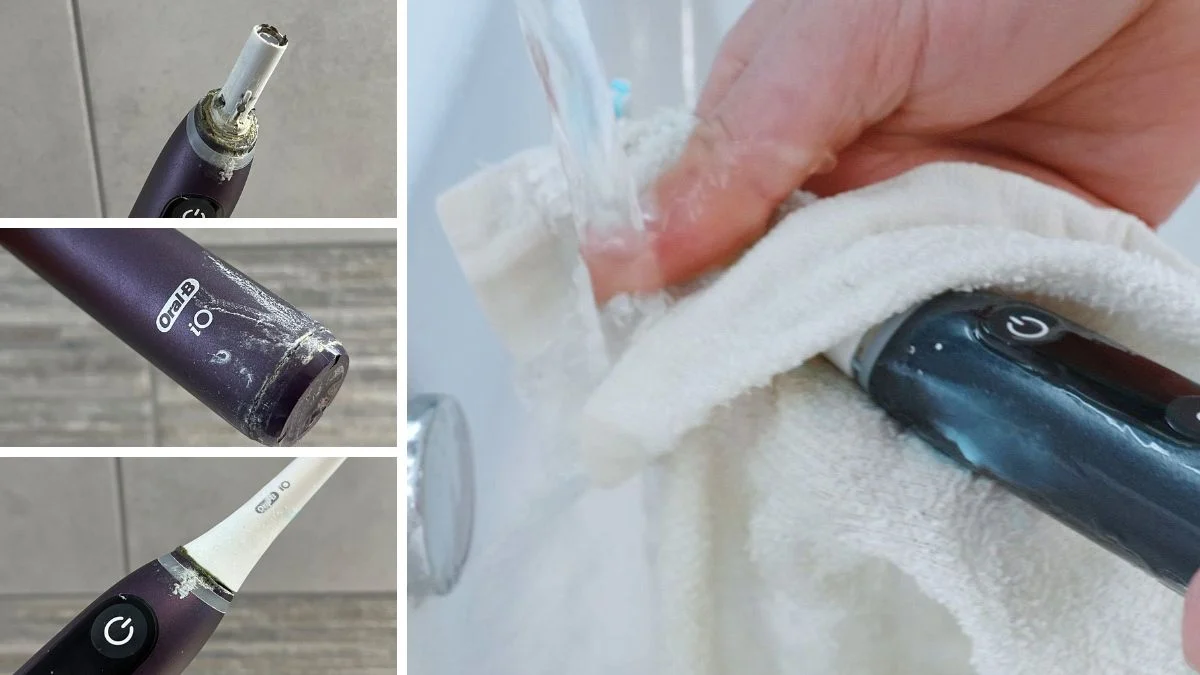
The design of the iO motor and heads makes it easier for muck and mold to build up within the neck where the brush head attaches. Even with thorough rinsing after each clean, we still find that grime tends to build up after a few weeks. We’ve found the most practical way to remove it is with a used interdental brush.
Brushes with large textured rubber grips do tend to be worse for dirt build-up than the smooth, all plastic handles of some brushes — examples here are the Pro 500 and Genius models from Oral-B. Residual toothpaste and gunk dries to leave white streaks. Cleaning from the textured surface can be much harder, particularly if you don’t keep on top of it. We advise prioritizing grip and comfort over ease of cleaning, though.
Battery life isn’t that important
Unless you are away from mains power frequently, don’t worry about battery life. The majority of rechargeable brushes last 3-4 weeks or longer on a full charge.
We’ve found Oral-B’s battery life to be the worst of the major brands. Expect 2 weeks on average, including from premium models. We’ve seen first hand how iO models with displays can suffer from excessive battery drain and give just 10-12 days use on average.
An overnight charge is sufficient for most brushes, but some can take as much as 24 hours if completely flat.
For most people noise isn’t an important factor, but some brushes are significantly quieter
For each brush we review, we use a decibel meter to take a reading of its noise level. So far we’ve found the range sits from 48 db to over 80 db, which is quite a variation.
Noise may be an important consideration if you’ve got young children that you don’t want to disturb, or light sleepers in the house who won’t appreciate the sound of a noisy motor.
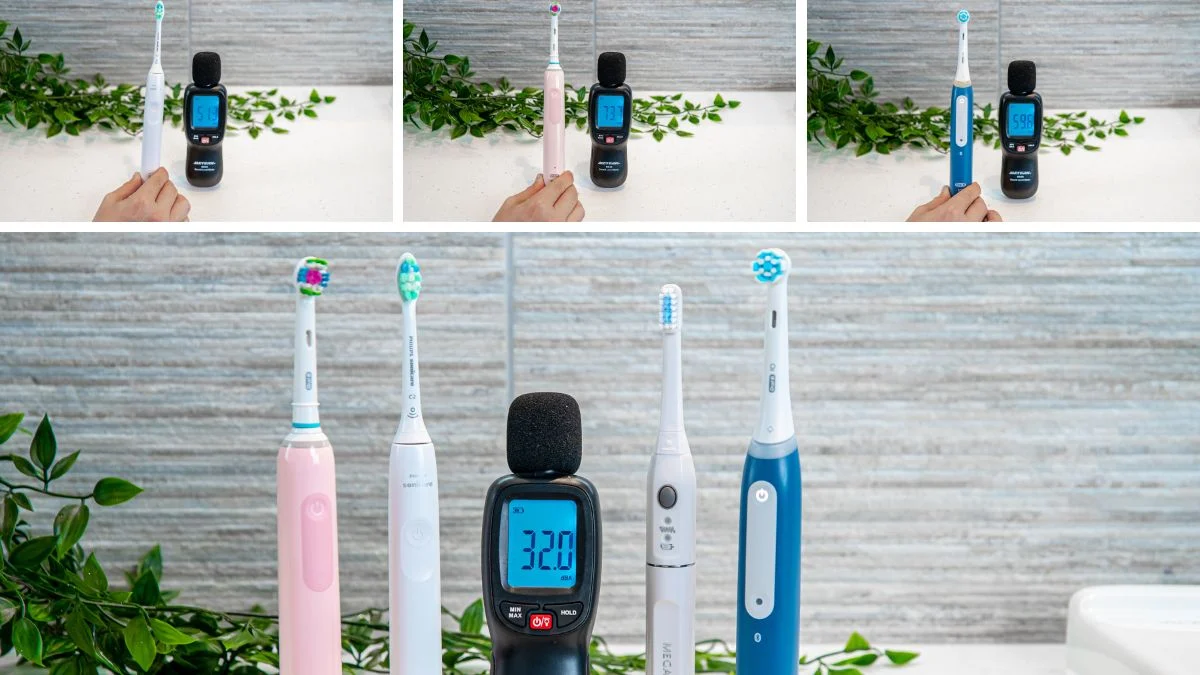
That being said, noise isn’t the biggest consideration for an electric toothbrush. Even with the noisiest brushes, we’ve found that a closed bathroom door drowns out most of the sound. But if you have thin walls or do have a need to be very quiet, it’s a worthwhile consideration.
We’ve got a post on the quietest electric toothbrushes that ranks from quietest to loudest. The winner so far is the Oclean X Pro Elite. From our list above, SURI is also particularly quiet.
What we regard as a 'budget' electric toothbrush
When it comes to categorizing 'budget', 'cheap' or 'affordable' the boundaries and expectations are different from one person to another. But for the sake of simplicity, we roughly group brushes into five brackets based on their selling price:
- $0-15: Too cheap — these products should be avoided
- $15-40: Budget — they do the job, but it's worth spending slightly more if you can.
- $40-80: Optimal — these products have the essential features, but no extra bells and whistles.
- $80-150: Mid-range — extra features that may be nice to have, but aren't strictly necessary
- $150+: Premium — the most capable if you want the very best, but overkill for most
These are not hard and fast rules and there are always exceptions. Years of testing and insight has given us a deep understanding of what makes a good brush and what you can realistically expect at different price points. As a result, we consider the best budget electric toothbrush to be one that is available for $40 or less. Our current pick is the Oral-B Pro 500:

You can get a good brush for $80 or less — spending more doesn't mean cleaner or whiter teeth
We’ve tested brushes that cost as little as $20 and as much as $500. Truthfully, you don’t need to spend more than $80 to get a reliable brush with the most important features. Our main recommendation, the Oral-B Smart 1500, is a good example of this.
The key features our in-house dentists recommend are a pressure sensor, a timer, and a pacer. Generally, you can get these from around $50 to $60. Many of the brushes we’ve tested in this price range are more than adequate.
Spending more money on a toothbrush may provide things like travel cases and better battery life, but these aren’t going to actually help brush your teeth better.
Don’t go too cheap, though
Based on the above advice you may be tempted to spend as little as possible. We would caution against this because we have noticed there are reliability issues with cheap brands.
And whilst you can get by without a pressure sensor, timer and pacer, ideally your brush should include them because they help you to brush properly and for the right amount of time.
There is such a thing as going too cheap with an electric toothbrush. In the years we have been testing brushes, we have yet to test an electric toothbrush that is less than $15 that really captures our attention in any serious way. Yes, inevitably there are some that are impressive options for the price, but there is always a compromise. What that compromise is depends on the brand and the particular model in question.
The big question that needs to be asked is how can something be produced this cheap; are cheap labor sources being exploited? What quality of materials are being used? Are the appropriate taxes being paid to sell such a product?
It does vary from one product to another, but our experience is that quality and reliability are often the biggest compromises. The product looks and feels cheap and rarely lasts longer than the 1 year warranty, if that long.
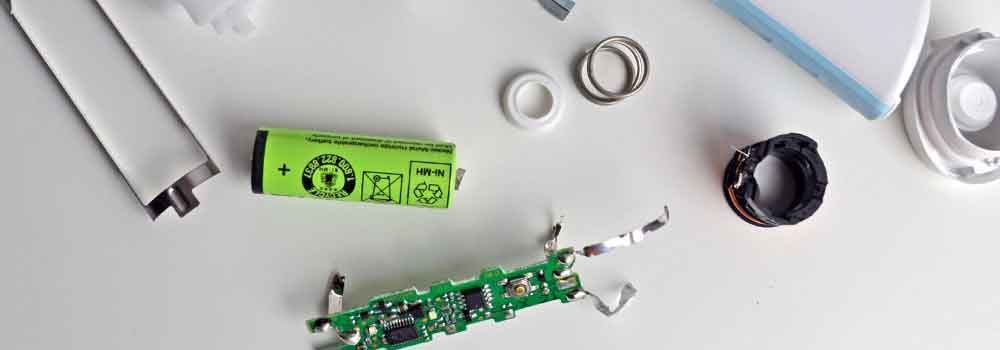
And because it is so cheap, it is easier and more convenient to throw away the faulty one and replace it with a new one, rather than repair it. Manufacturers know this and exploit this opportunity. Many work on the basis of making a profit by selling much higher volumes than their more expensive counterparts. The saying ‘pile it high and sell it cheap’ comes to mind.
We are not saying this is a dishonorable tactic, but it is one that doesn’t sit particularly well with us considering the environmental impact electric toothbrushes have. Selling a product really cheap isn’t typically sustainable long term. Keeping a high sales volume is particularly challenging and given the levels of competition in the market today it is far from easy.
This is something that the Chinese brand Fairywill has experienced. They did and still do make some exceptionally cheap products. But where they were once selling thousands through the likes of Amazon, they are now selling very few. This is because they had to constantly fight to become the top seller and be recommended by the algorithm. In order to achieve this, the company broke Amazon’s terms of service to gain high star ratings and sales on the platform. It ultimately led to them being kicked off Amazon and doing significant harm to their business overnight.

Ignoring the shady tactics and what it takes to sell on Amazon, the biggest losers are the existing owners of Fairywill products. With their main sales outlet now closed, Fairywill has been unable to sustain support for customers. It has gotten a bit better since, but for many months after being kicked off the platform Fairywill brush owners couldn’t get replacement brush heads or spare parts.
We have had many complaints of poor or no response to warranty claims. We can comment from first-hand experience on how communications with representatives from the company went unanswered. There is a cost to offering something cheap and that cost often is more impactful long term than paying a few extra pounds initially to get a better quality product.
Smaller companies and new brands don’t have the overhead costs of the major players like Oral-B, Philips and Colgate. They can bring better value products to market more rapidly. But the vast majority don’t have the same reputation, reliability and infrastructure in place.
You may well get an absolutely fantastic deal on a brush from a relatively unknown brand online, but when you need replacement brush heads where are you going to go? How can you be assured the replacement heads will be there in the future? And what if the brush goes wrong?
We don’t recommend smart toothbrushes for the average user
We’ve been testing smart (Bluetooth enabled) toothbrushes since they first launched around 2016.
Whilst we’ve found that the technology in the latest models like the Oral-B iO Series 10 and the Sonicare Prestige 9900 does work very well, it is overkill for the average user.
We generally don’t recommend them. You don’t need the tech to be able to clean your teeth well — plaque disclosing tablets work just as well — and to get the most from them you often need to have your phone with you when you brush.
A survey of our YouTube audience found that 57% had a smart toothbrush, yet 69% don’t use the features after 3 months.

Apart from the ‘smart’ technology, these brushes often come with additional cleaning modes and a travel case.
In our experience, there is little difference between most cleaning modes. Having a sensitive mode is useful, but this is included with far cheaper brushes.
A travel case can also be a good addition, but again, you don’t need to spend $300 to get one. We rate SURI as having the best travel case and that is far cheaper than a smart toothbrush.
Unless you are willing to spend the time and effort using the brush tracking technology that a smart brush offers, save yourself some money and go for a cheaper model.
Brush head styles aren’t that important, but do affect cost
Brush head ranges are unnecessarily complicated. There is no definitive evidence to say one head is better than another. Studies will claim to have found important differences between them, but this is always in comparison to a manual brush. We’re yet to see 2 Oral-B heads compared to one another in a clinical study.
We’ve tested the full range of brush heads from Oral-B, Sonicare and Colgate and found little to separate them. We’ve also tested generic heads, which are cheaper but still of an acceptable standard.
Sonicare’s premium heads have a silicone backing to them, which feels noticeably softer on the cheeks and reduces that harsh irritating sound if they come into contact with the teeth. But, we find it difficult to justify the price increase when normal heads work just fine.
The main thing you do want to watch out for if you’re buying generic heads is that you don’t get cheap counterfeits as they won’t do as good a job.
Sonic brush heads tend to be larger than the small circular brush heads found on Oral-B’s oscillating-rotating toothbrushes. Sonic heads have an oval shape to them.
We have found that Oral-B’s heads can sometimes make it easier to reach right behind the back molars and other tight spaces because their necks have a shorter length. This isn’t a factor worth giving too much importance to unless you have a particularly small mouth.
As a side note, if you are finding it difficult to reach certain parts of the mouth, it’s better to brush with your mouth almost closed. Having your mouth open extends your jaw and can make it harder to reach certain areas.
The brush you choose will affect how much you spend on brush heads
Pay attention to this because it could save you $100 over the lifetime of your brush.
If you’re buying official heads for a well-known brand, Oral-B heads for non-iO brushes (Vitality, Pro, Genius Series models) tend to be the cheapest.
Oral-B iO brush heads are almost twice the price of other Oral-B heads. The cleaning results are not twice as good. As it stands there aren’t many generic options available as an alternative for iO models. Those that do exist cost considerably less. You can get as many as 6 generic heads for the price of one iO Series manufacturer original. Sonicare brush heads tend to be more expensive than Oral-B, but there are good generic options available to bring the price down.
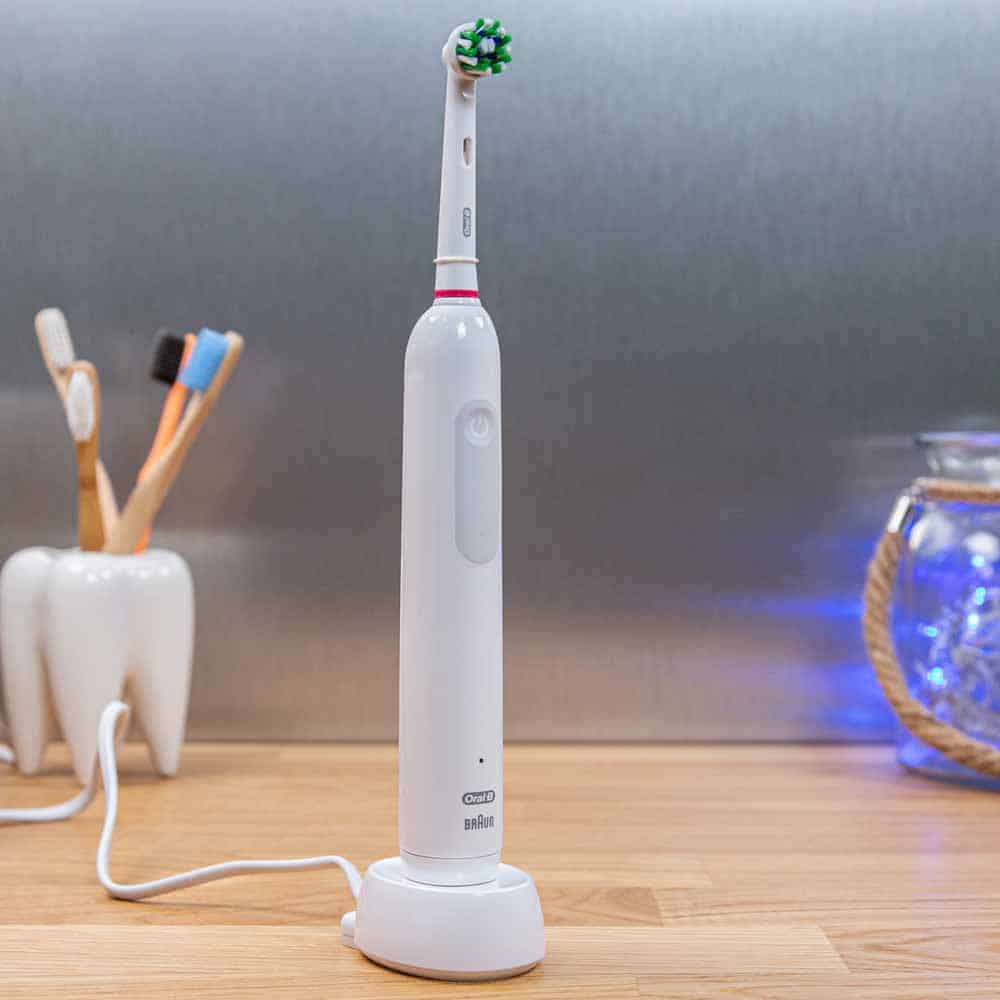
Try to buy heads where the bristle tips are rounded or smoothed off, like the manufacturer’s own. We found that cheaper generic heads often have ‘rough cut’ bristles. They still clean well but can be a bit more abrasive on the teeth and gums.
You can save money if you buy an electric toothbrush and heads from a lesser-known brand, but the caveat to this is reliability issues. We go into this in more detail in our post on the best cheap and budget-friendly brushes.
A word of caution though: sometimes there is such a thing as too cheap. We’ve read and heard stories of brush heads cracking, falling apart and bristles falling out as people use them.
Soft brush heads and sensitive cleaning mode are good if you have sensitive teeth or receding gums
Generally speaking, we haven’t found that cleaning modes and brush head styles make much difference to brushing experience. A standard cleaning mode and brush head do the job just fine. The exceptions, though, are soft brush heads and sensitive cleaning modes.
We have at times found it useful to switch to a soft head or cleaning mode during times of tooth or gum sensitivity. If you have sensitive teeth or gums, or some form of gum disease, these are particularly useful features.
Even if you don’t have sensitive teeth and gums, a sensitive cleaning mode or soft brush head can help to ease you into a new brush. This was the case for one of our team when we started testing the Oral-B iO range. The cleaning action of the brush felt more intense than previous Oral-B models, so we used the sensitive mode for the first week or so to get used to it.
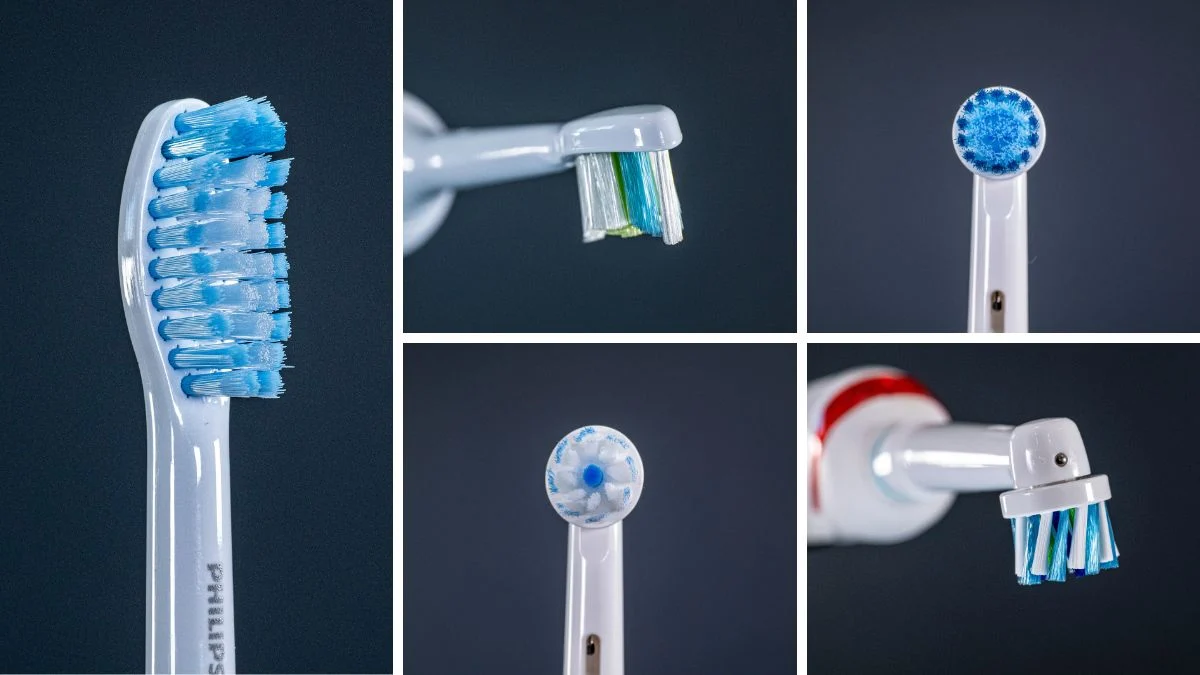
Oral-B and Sonicare both make soft brush heads for their full range of brushes, so this is something that you can add on afterwards if needed. Many brushes do come with a sensitive mode, but you’ll want to double check your prospective brush has it if it’s a feature you think you’ll benefit from. We’ve found the feeling of gentle cleaning modes doesn’t vary much from one manufacturer to another, so you don’t need to scrutinize this too much.
There is some variation in the way that gentle / sensitive modes are named. Some manufacturers instead refer to them as ‘intensity’ settings. A high and a low intensity settings are usually comparable to standard clean and sensitive mode.
Oral-B & Sonicare sensitive heads
For receding gums or sensitive teeth, I recommend you try the Pro GumCare head for an Oral-B brush.

For Sonicare try the G2 Optimal Gum Care for BrushSync brushes:

Or the S Sensitive for non-BrushSync brushes:

Some brushes are now charged via USB
The set up of your bathroom and the brush you choose will dictate how convenient it is to charge it.
Most toothbrushes are charged via a 2-pin charger.
Some newer brushes are charged via USB only, which rules out the opportunity to charge them in your bathroom, unless you have a 2 pin USB adapter. This may or may not be an inconvenience for you.
The Sonicare 1100, 2100, 3100 and 4100 are examples of this. They do fit and charge on the older style Sonicare charging stands too, so if you prefer your existing Sonicare charging stand, you can still make use of it.
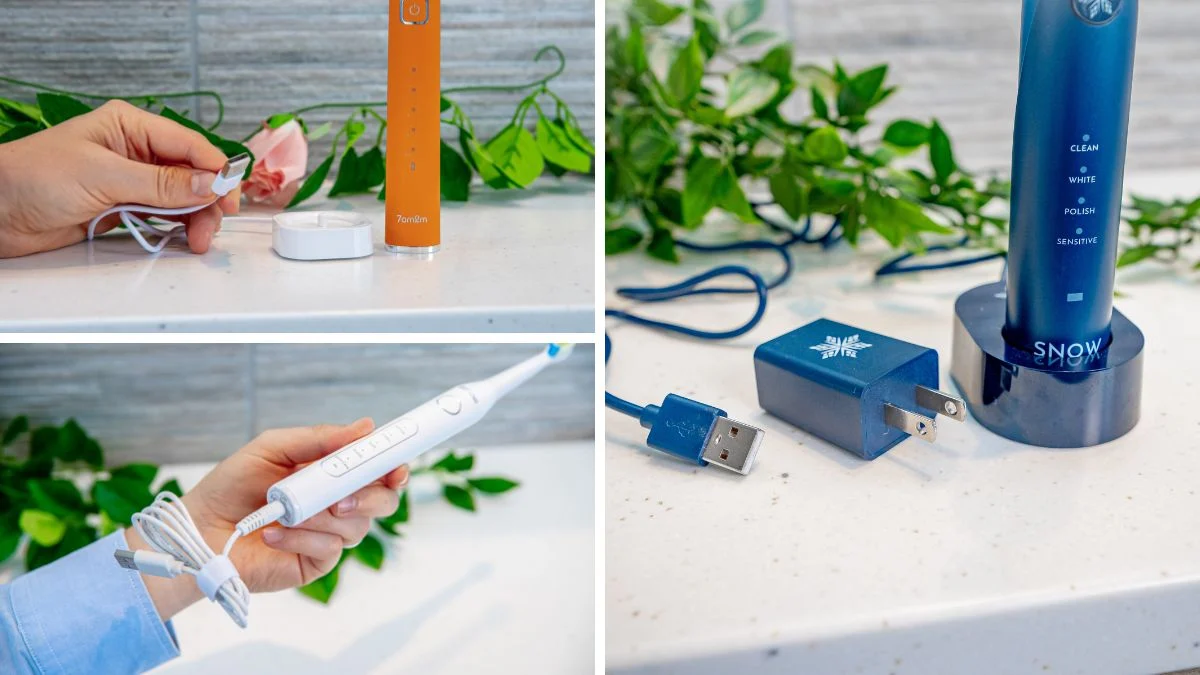
Some brushes can be charged in the travel case they are supplied with, which can add another option and more flexibility. SURI, as an example, is charged via USB Type-C. It can be charged within its case, using the same cable that charges many Android phones and the latest iPhone 15. We’ve found this to be a convenient way to charge the brush, especially as it only needs charging every few weeks.
A travel case is a useful accessory
In our experience the most useful extras to be supplied with a toothbrush are additional heads and a travel case.
Brush head stands and storage compartments can be convenient if you share a toothbrush with others, but are far from essential.
You don’t need to be a regular traveler to benefit from a case. Even if you occasionally go away for a night or two, a case protects the bristles from damage and dirt. Not to mention preventing other things in your wash bag from getting wet. It can also prevent that awkward buzzing sound in your luggage as you pass through customs!
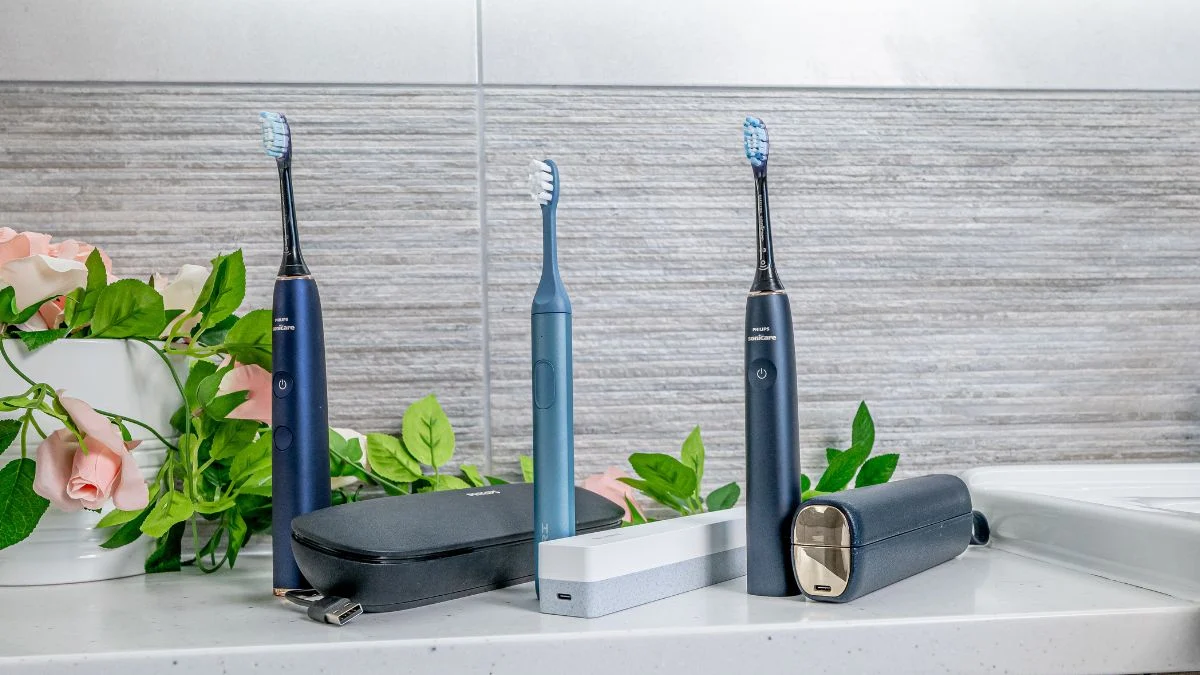
It’s well worth spending an extra $5-10 if you can afford it to get a case included. It’s harder to buy official cases afterwards. Third party cases serve a purpose but tend not to be as good.
Jon found a travel case useful during his recent Invisalign treatment. He was having to brush more regularly, often away from home, and having a case made things more convenient.
For those always on the go, charging travel cases are great. SURI’s is particularly slim and uses the same charger as most phones. Oral-B’s charging case is less convenient as it requires a bulky proprietary power adapter.
Things to consider if you’ve got dexterity issues
The majority of toothbrushes have a clean and minimal look with minimal textured surfaces for gripping onto.
Oral-B’s Smart and Genius models use different materials and textures to aid with grip. Although slimmer, the Philips One has a really textured handle, which makes it easy to grip. The Hydrosonic Pro from Curaprox is all smooth plastic, but the squarer design really helps with grip.
Aftermarket add-ons do exist but none are particularly pretty and do look like an add-on. Examples are:


The vast majority of brush heads are pushed onto a brush handle to attach and pulled off to remove. Few require twisting or locking into place. You don’t typically need lots of force to attach or remove them.
We’ve found that SURI brush heads are some of the tightest fitting and can at times require an extra firm grasp to pull them off. This might be tricky if you struggle to grip or have limited strength in your joints.
Power buttons are something to consider too. Colgate’s Smart Hum and Hum Rhythm are 2 examples that we've found to have firmer buttons than other brushes and make for a less enjoyable user experience.
Many brands have money back guarantees, so you can buy online, try and return if they don’t work for you.
More detail: our electric toothbrush reviews
In order to gather the advice and recommendations above, we've extensively tested and compared a wide range of electric toothbrushes. For the vast majority of brushes we test, we either complete a written review, a video review, or both.
In the sections below we've grouped our written reviews. You can see our video reviews and comparisons on our YouTube channel.
Oral-B
- Oral-B Pro 1000 Review
- Oral-B Vitality review
- Oral-B Pro 500 Review
- Oral-B iO9 review
- Oral-B Smart 1500 review
- Oral-B iO5 review
- Oral-B iO7 review
- Oral-B iO8 review
- Oral-B iO6 review
- Oral-B iO10 review
- Oral-B iO4 review
- Oral-B iO3 review
Sonicare
- Philips Sonicare Optimal Clean review
- Philips Sonicare DiamondClean 9900 Prestige review
- Philips Sonicare 3100 Series review
- Philips Sonicare 1100 Series review
- Philips Sonicare 2100 Series review
- Philips Sonicare 4100 Series review
- Philips Sonicare DiamondClean Smart review
- Philips Sonicare ProtectiveClean 4100 review
- Philips Sonicare ProtectiveClean 5100 review
- Philips Sonicare ProtectiveClean 6100 review
- Philips Sonicare ExpertClean review
- Philips Sonicare ProtectiveClean 5300 review
- Philips One By Sonicare review
Other brands
- Quip toothbrush review & comparison
- AquaSonic Black Series review
- AquaSonic Vibe Series review
- GLEEM battery toothbrush review
- Oclean X Pro Elite review
- Waterpik Sonic-Fusion Flossing Toothbrush 2.0 review
- Megasonex M8S review
- Emmi-Dent Platinum review
- Curaprox Hydrosonic Pro review
- SURI toothbrush review






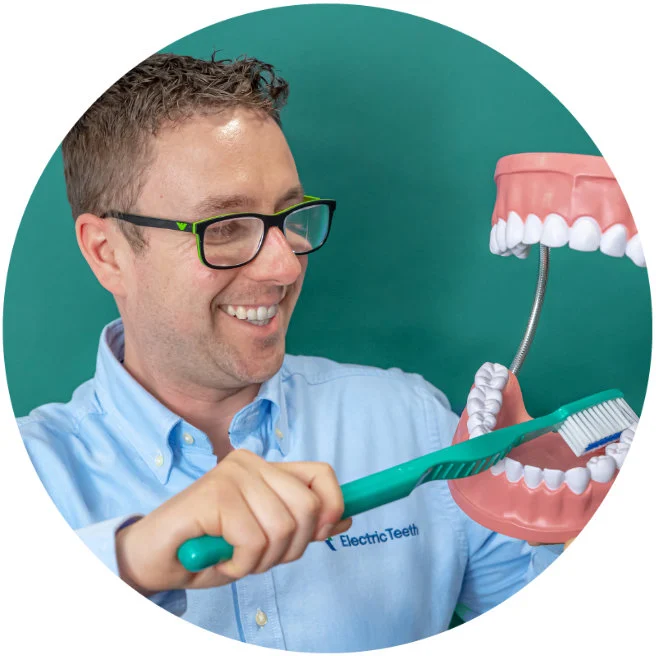
Will there be new models and reviews of OralB and Sonicare in 2024? If so, when would those be posted? Thanks for what you do!
If and when either company releases new models we will review them. 👍 At this time we are not aware of any new models coming. That's not to say they won't release something.
It's unlikely that any new product is going to be signifcantly different or worth holding out for as fundamentally all the brushes clean the teeth comparably.
It would be interesting to get your opinion about different electric toothbrush cleaning methods comparing brushing (sonic brushes clean buy brushing) vs. non-brushing (ultrasonic brushes - clean touchless with soundwaves).
Hi Frank.
Thanks for the comment.
We haven't done any extensive write-up on this in truth. So far we only really cover ultrasonic brushes in this article.
We are certainly not ruling out doing more testing/write-up of the differences. In fact, I have a Megasonex brush I am about to test.
But to date, we have been led by the evidence, demand and availability of the sonic brushes. From what we understand, these deliver much better value for money for the vast majority of users and perform really as well on the whole. Thus the premium to be paid for ultrasonic isn't justifiable for most.
Hi Jon,
thanks for your reply.
Providing a good overview of all cleaning technologies available will give your readers the opportunities to choose the one that works best for them. Cleaning with ultrasound is much less known - but has the advantage of non-abrasive, no-brushing deep-cleaning ordinary sonic or manual or electric toothbrushes cannot deliver. For people with sensitive teeth/gums, any type of gum disease/inflammation and pre/post oral surgery this is often the only cleaning method available.
When testing true ultrasonic devices you might want to include emmi-dent, because their patented technology is actually clinically proven to remove bacterial plaque - even underneath the gumline where ordinary brushes cannot reach.
Hello, Thank you for this site! It's quite informative and it seems down-to-earth with it's style and advice.
Over the years, multiple dentists have said I have a smaller-sized mouth and was wondering if I should get a "kids" electric toothbrush instead of the adult size. I'm concerned about the size of the heads on electric toothbrushes. Will they really fit my mouth to get into all the tough to reach spots? I have a few partial or full crowns. Other than that, my teeth are average with a bit of crowding in one area.
What would you recommed?
Hi Carolyn.
You can use a kids brush head.
With Oral-B and Sonicare brushes, the kids heads fit to the adult handles. Thus you can benefit from features & designs for adults, but still, get the benefit of the smaller brush heads.
The kids heads tend to be about 10% smaller on Oral-B heads. And Oral-B heads tend to be the smallest overall, thus most likely suiting you better.
You might want to try a regular adult head and see how you get on and then you have the option of getting a kids head if you do want to try it.
Most people can accommodate a regular adult's electric toothbrush head. I am not sure what you use now, but if you are using a manual brush for example they are no bigger really.
The electric brush heads will work fine with crowns, full or partial.
It is always 'best' to get personalized advice from a dental professional who has made an assessment of your teeth/mouth. But, you can probably try our top recommendation, the Oral-B Smart 1500. If you feel the head is too small, then buy and fit the kids head to it.
Thank you for the advice!
Is there a specific model that is best for inflamed gums or best for getting gums in good health? I noticed that Phillips Sonicare only has one that mentions gum health, but I have read that all electric toothbrushes are good for gum health. I would appreciate your thoughts........thanks,
Yes you are right all electric toothbrushes are generally good for gum health.
It is important to ensure you are brushing for the correct time and with the correct technique too.
You don't need a specific gum health mode on the brush for your gums to benefit.
You may want to opt for a soft brush head if you have particularly sensitive gums.
Hi, thanks for all your reviews. I am wondering is there really any major difference between my oral b toothbrush I bought 7 years ago and one that's out today? They both us the same heads, mine has a 2min timer and I don't really care about not having a pressure sensor. Would there be any reason I need to upgrade?
Hi Mike. If your current brush is working just fine I see little reason to upgrade.
Battery life will have improved. The newer handles are slimmer and there is a little more power in the motor, so more brush head movements. But, fundamentally these make no significant difference in how well the brush cleans the teeth.
I would stick with your brush, changing only when it has come to the end of its usable life.
I tookphillip soni care platinum tooth brush to UK USED CONVERTER ADAPTR AND IT WOUD NOT CHARGE JUST FLASHING GREEN LIGHT IS IT UNUSABLE NOW?
I am afraid I can't say for sure. It is odd that it did not work. It might be a sheer fluke that it stopped working as you went traveling with it. It may need repair, if within warranty period.
I bought an Oral-B BrAun PRO timer sonicare toothbrush for my granddaughter, who lives in a different State than myself. She came to visit recently and she was so excited to show me her new toothbrush. She had the brush wrapped in cellophane to protect it, since it had no plastic protective cover. I bought my other granddaughter a lesser priced electric toothbrush and it came WITH a protective cover. Was this a faulty packaging problem? I would appreciate you helping me resolve this issue please. Very unsanitary. If I would have known this , I would have made a different purchase. Thank you for your time.
Brenda, when you say 'protective cover' do you mean a case that covers & protects the whole toothbrush or a cap that goes over the brush head only?
Oral-B kids brushes don't typically come with a travel case or a brush head cover/cap.
Have you heard of silk’n dental ir toothbrush?
Their product is called toothwave, and they claim it uses some kind of radio frequency waves to clean.
Hi Andy. Yes, I have heard of this, but I have not tested it as of yet. It is on the list to test in the future.
We’ve used a few electric toothbrushes down through the years. Various Sonicare models…recently the Boka electric. My favorite to date is the Curaprox Hydrosonic Pro. For reasons unknown (possibly a virus or allergic reaction, new toothpaste… who knows?), I suddenly (like almost overnight) developed highly sensitive, swollen, PEELING, bleeding gums. It was right at the beginning of what folks are calling the pandemic and routine dental care became essentially unavailable. So I started researching it myself. I initially discovered two manual brushes (Nimbus and Curaprox 5460) and both were better than the Boka as far as being kind to my gum issues (whatever they are) with the Curaprox being slightly kinder. Given that I attributed the difference to the Curaden bristles I decided to try their electric model. This is the first electric toothbrush I can honestly say I enjoy using. It’s not overly technified, only feature, really, is 4 x 30 second notifications. Otherwise it just brushes. It holds a charge for several weeks, which I like, offers power, sensitive and solo brush heads and stores in a very nice travel case (though a charging feature would be an excellent upgrade). I’m using the sensitive brush head, as you can imagine. Two final steps in my routine, just recently added, are interdental brushes (again, Curaprox from similar reasoning - the Curaden bristles) and PerioScience AO series toothpaste, mouthwash and topical gel. Everything seems to be coming together as my gums are doing better daily. A review of the Hydrosonic Pro would be something I’d enjoy reading if you’re able to manage it. I know, feature wise, it’s not on par with that Sonicare 9900 but for me, it’s been perfect.
Hi Ken. Thank you very much for the comment and feedback. So pleased to read you have found a brush that works for you.
The Hydrosonic Pro from Curaprox is on our list to review in the near future. Just haven't quite gotten to it yet!
I’ll be watching! 😄
Just FYI - I read your review of the Boka brush (since it was my previous brush) and I agreed with your review completely (save, potentially, one point) I will say, in every category you list, the Curaprox pulls slightly ahead (IMO)
Styling - Yes, the Boka is a “clean” design that’s pleasing to look at and use. The Hydrosonic Pro, even more so. One big add is the battery indicator. I found it difficult to know how much charge the Boka had left. The Hydrosonic Pro has an attractive blue led stripe giving you a very easy indicator.
Brush heads - You mentioned the charcoal bristles were maybe more fad than fact but not necessarily a negative. Possibly, but I’m not convinced they weren’t at least a factor in the issues I experienced. The Curaden bristles are (again, IMO) vastly superior in that regard, and I’ve come to the opinion that bristle material, composition and design are (or should be) one of the primary criteria when selecting a brush. This is likely just for people like me, not for people who have no negative effects from nylon bristles, charcoal bristles etc, naturally.
Travel case - this being included with the Hydrosonic Pro made it a no brainer to take these brushes with us on a recent trip. Our last trip, we left the Bokas behind and simply packed our manual brushes. A small thing but even so… Beyond that, there’s daily storage at home. It’s well understood that the bathroom is, by far, the least sanitary room in our homes and storing an open, uncovered brush in the bathroom is undesirable (have you ever addressed this issue?). With the Boka we tried to minimize that exposure by storing them upright, in a cupboard, using their included cap. Well enough. Only problem was, it’s fairly unstable in that position and they would get knocked over routinely. But with the Hydrosonic Pro, I use that same travel case. Covered and stable for the win.
In most other regards, I find the two brushes very similar in form, function and use.
Thanks for the extra feedback Ken, all great stuff!
We haven't done extensive research about how sanitary a bathroom is and the best place to store your toothbrush.
It would appear from some research that the risk to the toothbrush is often overplayed. It isn't quite as bad as some think. Yes, keeping the brush away from the loo will always help, but there doesn't seem to be lots of evidence to suggest you must take lots of steps to protect the toothbrush. I reiterate we haven't done lots of research to confirm, so there might be data against this.
Most leading dental organisations recommend any special steps or the need to sanitize the toothbrush after or before use.
Keeping the brush in a case or cupboard will of course help, providing it is ventilated. A toothbrush head stored in damp conditions can potentially cause bacteria to grow on the head. The bristles ideally need to dry out between uses if possible.
All said and done most toothbrushes are very similar and serve the vast majority well. Personal circumstances and desires will always have a part to play and particular brushes will stand out for one reason or another, as you have found yourself.
👍
Dear John, I used an Oral B and tried in every way to keep it clean -- the hole in head, the seal at top and bottom. Is there any electric toothbrush with elegant engineering design to solve all these surface easy to keep clean problems. I tried putting heads in kangan water high ph, scrubbing 2 seal lines with toothpicks. Is the oral b type design all there is. How to keep clean? It sorta looks like 2 of the 3 oral b heads have smaller holes in their shaft. I really appreciate your help.
Hi Tamara. All the Oral-B heads have holes in their shaft.
I can't say there is 1 toothbrush that is much easier to keep clean. Sonicare models a bit easier as they do not have holes in the brush head shaft and tend to have less rubber grips on the handles so less nooks and crannies for possible buildup of dirt etc.
Thank you for your expertise. I'll look at sonicare.
Isnt it time to get silicone or rubber brisstled heads?
Will it increase the price? Why?
We haven't really found them to be as good yet. Those that do exist tend to be a bit more expensive, most likely due to the more specialist nature. This design is not commonplace as yet.
We are looking to share a handle (not the brush heads) and have limited counter space. Ideally, the unit would include a charger and a place to store the brush heads. Is it me or are these difficult to find? I can't seem to find an Oral B or the Sonicare versions that meet our needs.
If not, what is the best way to store the brush heads after each use (from a cleanliness POV).
Thank you!
Hi Paul.
Great question. The good news is that there are options.
A great option is the Oral-B Smart 3000. Our review is available here. It comes with a brush head storage compartment. It does have Bluetooth Smart features. But these don't work well when sharing the handle. But you don't have to use this feature.
The brush head storage compartment is as small as it can be really considering it holds 4 heads. But, it is larger because it hold 4.
The benefit here is it all comes in 1 box.
Alternatively, you can purchase pretty much any Oral-B toothbrush and then buy this accessory, to clip around the charging stand. It will hold 2 brush heads.
I link you to the official part, but there are cheaper equivalents such as this on Amazon.
You can get equivalent holders for Sonicare, but they don't tend to come in the box as standard.
I hope this helps. If you need more assistance, please let me know.
Someone mentioned that Phillips Sonicare and Oral-B is both equally good eletric toothbrushes. But why do Phillips thinks they are better than Oral-B and Oral-B is better than Phillips? Phillips try their best to equally remove the same level of plaque as Oral-B. And also, I think saying “Im the one that removes way more plaque than you” phrase should stop because it will hurt the other eletric toothbrush company.
This is a battle that has and will continue to exist. Each brand wants to outperform each other, it is the marketplace we have created as humans. It is the same for other product categories, be that cars, technology, etc. Each is trying to appeal to the consumer in one way or another and validate claims.
There are studies that show Oral-B clean better, removing more plaque, then there are studies that suggest Sonicare removes more plaque. The data in each is valid, but the studies are usually small.
As a general rule, whilst the data does seem to stack up in favor of Oral-B slightly, the reality is the differences are not necessarily significant and what differences do exist rely on correct and regular use of the brush.
In everyday use, both are great and more than good enough. Heck, used correctly a manual brush is sufficient.
It would be nice to see a little less competition and more working in favor of happy, healthy smiles, but both do work on this goal too. I don't expect to see any change in the competitive speak and claims.
Hi,
Could you please recommend a smart toothbrush, I understand that a cheaper one will do the job, but I find it easier with as app showing me my progress as well has how long I should do it.
Thanks
Hi Amrith,
If money is no issue then the DiamondClean Smart is the one to go for. You can read our review of it here.
Oral-B has recently released the iO, which we have reviewed here, but we still recommend the DiamondClean Smart over this.
Hi, I was hoping to get a recommendation
I live in Canada
I'm looking for a sub $100 range, preferably with smart features.
Also how does Phillips stack up against oral b, considering one specializes in oral care.
Thanks
Hi. The recommendation we have for Canda is the same as for the USA. In fact, we do have a Candian site with recommendations available here.
The Sonicare ProtectiveClean 4100 is an excellent choice in my opinion.
Both companies specialize in oral care and ultimately there is not a great deal to choose between them. Both offer brushes that clean the teeth well, they are just different. Technically, Oral-B offers a better clean according to the clinical trials, although ultimately more trials are needed. However, Sonicare offers a better value package in the form of the 4100.
My view is worry less about the brand and the particular brush and worry more about your brushing routine and technique as this will deliver more effective results than the brush alone.
If you have specific questions you would like answered, please let me know.
If you have a
I'd like to see a review of that teeth cleaner that looks sort of like a mold of a complete set of upper and lower teeth. It appears that there is one on the shelf behind you when doing a comparison review.
Please show me where to find -
Thank You;
Mike Stancil
Mike.
The product you are referring to is Amabrush, which is one of a number of different mouthpiece style toothbrushes.
Conceptually these are great. In reality, none are suitable alternatives to a regular manual or electric toothbrush yet, as I explain in our mouthpiece toothbrush article.
Please consider reviewing the TAO Clean toothbrush with UV cleaning station for your 2021 recommendations?
Thanks for the request. We will add this to our list of products to consider reviewing and of course if we deem suitable include it in our recommendations.
hello
I am greatful to find this site
is Philips Sonicare ProtectiveClean 4300 better than Philips Sonicare ProtectiveClean 4100 ?
thanks for your efforts
Thanks for the question. They are essentially the same brush. The 4100 is the model sold in the USA primarily, whilst the 4300 has been designed for the UK/European market. The box contents and charging stand differs. However, from a cleaning performance point of view they are the same.
Have you evaluated the Sonicbrush?
I've used a Sonicare for years and was thinking of changing to this type of method. Thank you.
Is this the product you mean when you refer to 'Sonicbrush'?
If so, please avoid, as we explain here: https://www.electricteeth.com/mouthpiece-toothbrush/
Which one do you recommend for people with small mouths and who gag easily?
Hi Kate.
Typically a toothbrush, with a small brush head is going to be best. So, I would suggest looking at an Oral-B model. The Pro 1000 is a great option.
It is a similar price point to the mentioned Sonicare ProtectiveClean 4100, but the battery life is not quite as good.
You could also consider the Pro 1500, which is a slight upgrade on the aforementioned Pro 1000, with twice the battery life.
I suspect you know this already, but it is going to take time and practice to try and train yourself not to gag.
sonic vs electric toothbrushes - any differences? Are these the same basic thing?
Hi Alison.
The words 'electric toothbrush' are a broader headline term to describe a type of toothbrush.
A sonic toothbrush is a type of electric toothbrush.
Essentially all types of electric toothbrushes work towards the same goal of cleaning the teeth effectively so that you and I can have cleaner and healthier teeth and gums.
The main 2 types of electric toothbrushes are Sonic and Oscillating-Rotating.
If you click here, we have a more detailed explanation of the differences that I really hope you will find useful.
Hi. I would like to know why the Burst toothbrush did not make the line up for 2019? I noticed one of the con's you listed on the Burst review was the cut of the bristles. Do you think these bristles are not efficient and effective at cleaning, or that they may do harm to teeth and gums? I like the look, price, and subscription offered by the Burst. However, I would not put these likes before caring for my teeth and slightly receding gums.
Hi Shannon.
Simply put, there are many great choices, all of which could with justification make it into the best list, Burst included.
Overall, I quite like the Burst toothbrush. It is a perfectly capable toothbrush and just because it hasn't made the list does not mean you should not consider it.
Personally I did find the bristle cut to be a bit different and not quite as pleasant to use initially, but that is just my opinion. It would be unfair of me to suggest you are putting your teeth and gums at risk.
I do think the charcoal bristles are a bit overhyped, there is limited clinical evidence to the benefits these bring.
The fact that so many dental professionals recommend Burst is a very positive thing, however a degree of cynicism is that they get a commission for doing so.
I am not suggesting all do this for the money, the majority only recommend what they believe in.
To try and keep things simple, we have broken the 'Best Electric Toothbrush' down into 10 categories. Those in my opinion, that Burst may have contended for are, best overall, best subscription and best for receding gums and sensitive teeth.
The reason it hasn't taken top spot in these categories for 2019 is that ultimately we feel the competition just beats Burst within these categories.
We consider a whole range of things when compiling the list, from brush features, price, reliability, availability, clinical evidence, brand reputation, etc.
To further clarify, the Sonicare ProtectiveClean 4100 (the recommended 'best overall product' at the time of reply) presents a subscription free purchase, which is widely available (not sold online only, like Burst primarily is) with many great features, clinically proven performance from a brand that many recognize and trust. For the average user, this represents a good option, because things like replacement brush heads can be purchased from the local drug store etc, whereas this is not possible with Burst.
We are certainly not saying Burst should not be one you consider. If you think it is better suited for you, then great.
I hope this answers your question and provides a little more insight.
Thank you for your quick response Jon. The fact that the positive reviews for the Burst are all coming from Burst ambassadors has been a big reason for me not having already purchased this trendy rose gold toothbrush. Your unbiased review is very much appreciated by an over thinker like myself. I suppose all that is left for me to do is try the Burst under the 90 trial and formulate my own unbiased opinion. If I don't like it I will purchase my third Sonicare Diamondclean and hope that is lasts longer then the 2 year warranty this time.
Shannon.
Glad I could be of some assistance and pleased to see that I am not the only one who has noticed the recommendations all being from Ambassadors.
If you do try Burst, I would love for you to let me know what you think as insights and impressions from users like yourself are so valuable.
Jon,
I couldn't resist taking advantage of an early Black Friday deal from Burst. I will definitely update you with my first and lasting impressions in 60 - 90 days.
Hello! I'm curious if you test durability or reliability? I currently have a Phillips Sonicare DiamondClean that just died. I think the power button is stuck and now won't even charge. It is just over the 2 year mark and based on other reviews it doesn't seem as though Phillips will do anything about it. $200 is a lot to spend on something that just lasts 2 years...any that you think will last longer? Or is that the standard for electric toothbrushes? At $40-50 I think 2 years would be acceptable.
Hi Jennifer.
Thanks for the comment.
I have heard quite a few reports about the Sonicare DiamondClean and its durability.
I cannot comment how regularly these products fail, but inevitably, there tend to be more reports of when it fails than praising it for when it works, so sometimes issues can seem worse than they really are.
You have clearly been unlucky and it is a shame it has failed after the warranty has run out.
Whilst I don't have scientific data, the durability of brushes tends to be well in excess of 2 years, more towards 5+ years on average.
I certainly would have expected the brush to last longer.
In terms of long term testing and durability, there is only so much we can do.
We do use some brushes on a long term basis, but we are a small team and there are lots of brushes on the market. However, I can say we had a DiamondClean that failed a little after the warranty period. In our case the button didn't appear stuck, but it would not turn on.
We are not a testing/durability lab with specialist machines and processes that can really test the brushes to destruction as it were. It would be nice if we could do this, but sadly we don't have the funds for this!
Hi,
I love your website and I have read so many good things here which helped me but also made me confused or better to say made me rethink my choice. I'm in active search for new toothbrush and problem that I have is kinda specific so I hope you will be able to help me with making right choice. I'm about to have some serious dental work, 4 implants in upper jaw (2 with their own crowns and 2 with 4crowns bridge) and also if it will be possible two implants in lower jaw, never the less point is that those require to be cleaned perfectly thus electric > manual. My mind was set on Sonicare mainly because in had rotating electric brush in past and it was really harsh to my teeth so I decided I dont like round/rotating heads. But after reading lots of your reviews I'm now not sure and looking at Oral-B as possibility. I dont need too much gizmos but I'm not running away from them either. Pressure sensor is must for example because with manual I always had problem with being harsh on my teeth and rubbing as mad. That is maybe one of stuff that made me develop animosity to rotating brushes, if I pressed to hard. So do you have some suggestion for me? Thank you in advance for reading and answering.
Hi Filip.
I am glad you have found our website helpful. I do apologize that it has perhaps also complicated your decision making process.
Sonicare and their sonic cleaning action or Oral-B and their oscillating-rotating cleaning action toothbrushes are both perfectly fine to use.
Many are concerned about using electric brushes on implants/dentures/bridges and other cosmetic dental work, but they are fine to use (unless your dentist says otherwise).
Personally, I generally prefer Oral-B's cleaning action, but I know many who have tried it and not got along with it. The same can be said for Sonicare.
Clinical studies exist for both brands claiming how well they clean, but generally Oral-B takes the edge. However, in day to day life they really are just as good as each other when used correctly.
The gizmos are nice to have, but you often pay a premium and very few really get the value from them.
I would suggest you look at the Sonicare ProtectiveClean 4100 and the Oral-B Pro 1500. Both are pretty much on par for specs.
Prices are always subject to change, but the initial cost of the Sonicare may well be cheaper but over the lifetime of ownership, the Oral-B will be more cost effective.
Both brushes do have pressure sensors, although I do believe Oral-B's implementation is slightly better.
Sonicare win's on battery life, but the Oral-B will give you 2 weeks on a single charge.
Ultimately it will be personal opinion. I wouldn't rule out trying Oral-B again if I were you.
The good news is Oral-B has a 60 day money back guarantee and Sonicare a 90 day, should you need to use it.
I hope this helps. If you need any extra information, just let me know.
A lot of clinical trials are finding that O-R toothbrushes clean much better than sonic. (Eg https://www.ncbi.nlm.nih.gov/m/pubmed/29758154/?i=2&from=/30375187/related). What do you make of this?
Hi Alex.
Yes, many clinical studies have found that oscillating rotating toothbrushes are better.
However, these tests are run under clinical situations and in reality, when you take into account everyone's different brushing styles, or not brushing for the right amount of time etc, in the real world, for most there is little difference.
That said, our general preference is for oscillating brushes.
When it comes to suggesting the best though we try and take in a number of factors and at present, the Sonicare still offers a fantastic clean and is in our opinion a better all round package at this time.
I have the benefit of buying a cariPRO through my insurance for a very very good price over retail.
I have used oral b for about 15 years. The thing is I cannot find a true review of this brand. All reviews are from people who were given the product which tells me nothing really. Thanks
Hi Mike,
Thanks for the comment.
The cariPRO is a brush we have become aware of in more recent months. We have found like you that most people have been given one to review and have fairly positive things to say, as you might expect.
We hope to review this product in the near future, but I can't say when this will be exactly.
If I were you, stick to what you know and that is proven.
Any further questions, please let me know.
If I wasn't confused enough before, your site has gotten me there. Why is your Best electric toothbrush recommendation different for the UK than it is for the US?
Hi Steve,
The toothbrush features and prices differ slightly from UK to US - even models with the same / very similar name are not necessarily like for like. We therefore have different recommendations for each country. Let us know what sort of price range and features you're interested in, and which country you're in, and we'll give a couple of recommendations.
Hi Jon,
I would appreciate if you give a quick comparison summary between Sonicare 4100 and Oral-B 1500, using your categorized breakdowns. I believe many other prospective first time users would appreciate this comparison of two later models.
Best,
Amar.
Hi Amar,
A full written comparison is on the list to do, but here are the main differences for you.
The cleaning action of the brush head is different. Oral-B has the small round oscillating-rotating brush head, with pulsations compared to the side to side sweeping movement of the Sonicare.
The 4100 ProtectiveClean has Sonicares BrushSync brush head reminder system. You can learn more about that here.
Sonicare offer a range or brush heads, but you ideally want to use their newer, more premium 'BrushSync' compatible heads to take full advantage of the features that are on offer.
You will typically find each brush head from Oral-B is a couple of $ cheaper.
The 4100 has just 1 cleaning mode (Clean) compared to the 2 modes of the Oral-B 1500 (Clean and Sensitive).
The Pro 1500 has a visible pressure sensor on the rear of the handle. The 4100 has a pressure sensor, but not the visible light like the 1500.
The Pro 1500 has a 2 week battery life as does the 4100, but in hand, testing has had the 4100 lasting up to a couple of weeks longer.
The Pro 1500 comes with a US charging stand, as does the 4100, but the Sonicare stand has support for global voltages should you travel.
Those are the main differences.
Just to recap a few similarities. Both brushes are similarly, have a built-in 2 minute timer, quadpacer, rechargeable battery, 2 year warranty and 1 brush head in the box.
i hope that helps.
Thank you very much. It does help, and as I am not from the States, the voltage factor has the deciding say. Forgive me if I'm wrong, but I don't remember reading about the voltage on your reviews, and believe your international readers would praise if you include this difference in your future reviews. Of course I read both reviews, and even the differentiating techniques of the two companies, but such eye-to-eye comparison tells me clearly what I'm gaining and what I'm losing for my choice. Thanks again and keep up your splendid in depth reviews!
Hi Amar,
I do normally include information about the voltage/charging stand in the reviews, but it is possible that I may have forgotten to do so on one or two reviews. If you need more information please let me know.
Hello, I've been thinking about getting my first electric toothbrush, and had settled on the Oral-B Smart 5000. Then I noticed I could get a Philips Sonicare ProtectiveClean 5100 for a similar price, and a bit of research lead me to your site. I see a lot of people say they prefer Oral-B brush heads, both for comfort and replacement cost. Any advice?
Hi Andrew.
Thanks for the comment.
To be honest, it is often a personal preference at the end of the day.
On a more technical level, the Oral-B's do tend to clean the teeth better and the brush heads are cheaper to replace, hence this is why many prefer.
Sonicare tend to be quieter brushes and feel a little more premium, whilst offering better battery life. If you use either brand of brush correctly, there will deliver a superior clean to a manual brush.
If you have any specific queries you need answering then just let me know.
I have had a Braun 3D excel now for about 20 years that is just starting to go. (Got my money's worth from that one!) I need a replacement and need it to be simple. The fewer choices the better for me to not over think and just get it done. Do you have a recommendation which would be most similar to that one?
Hi Denise,
I had to look that model up. I can see it is from the mid 2000's so, yes it is fair to say you have gotten your value from that one!
My go to recommendation for no nonsense, simple to use Oral-B brush is the Oral-B Pro 1000.
It does a good job of cleaning the teeth and is great value.
If you want to learn more, check out my review here.
Any questions, just ask.
I owned a phillips toothbrush for years, bought the brushes online, but the battery finally died. I am 77 years old with many crowns and each toothbrush I have bought end up buzzing too fast, tickling my gums, tongue and shaking my teeth. Which toothbrush is available that is not so intensive and I do not like the round brush heads. Any help from you would be great.
Hi.
If you don't like the round brush heads Sharon, it will be a case of sticking with Sonicare like you have had previously.
Most are going to move at a high speed though unless you use them on a sensitive/gum care mode. Have you tried brushes with these more gentle modes? If so did you still feel the tickling/buzzing sensation?
Great site, Jon!
I just purchased a Sonicare 5100 Protective Clean Gum Health (with a coupon I paid $60 at CVS which I know is a very good value!).
I am wondering now if upgrading to the 5100 (from a Sonicare Gum Health Series 3) is worth it. After reading your review, I am convinced the 5100 is a great brush but is it worth the extra features from the Series 3 which is only a year or two old? I don't like clutter or waste and if I do keep the 5100 (I haven't opened the box yet so can still return it) my other brush will never again be used again. I'm okay with that if you think the 5100 is worth the upgrade. Many thanks, Nora
Hi Nora.
Thanks for the compliment on the site. 😍
Wow that was a good price on the 5100, good work!
Whether it is worth it, is always a difficult question and is somewhat is a personal opinion.
Normally, based on the presumption that the 3 series is working fine, unless you needed the extra features it would not normally be necessary to upgrade as the 3 series still does a good job.
You will likely feel the 5100 is better, but there wont likely be significant benefits to you, although there are some nice features built in such as the pressure sensor, brush sync technology and the travel case that is included.
Given the price you bought it at, it seems a shame to return it, but of course no point keeping it if you won't use it.
You obviously felt it was worth buying in the first place, so that says something to me.
I would probably keep it.
You could move to it and sell on the 3 series brush handle, you will get a few $ for it. Perhaps you could pass the handle onto a friend or family member who may benefit.
You could always gift the 5100.
Or keep it as a spare, should the 3 series fail.
The choice is yours.
Thanks so much for your thoughtful and thorough reply, Jon!
I wish all review sites were as well researched and detailed as yours.
Based upon your comments above, I'm keeping it. I do like the extra features, especially the pressure sensor and brush sync, which are lacking in my older Series 3.
And, you're right, since I felt it was worth buying in the first place, that says something to me also. You are very intuitive and I suspect it goes beyond electric toothbrush reviews! :)
Thank you again, Jon!
Nora
No problem Nora.
Thanks for the positive comments.
Once you have used the 5100 for a couple of weeks, please do come back and let me (and others reading this site) know what you think. 😊
What kinds of tests do you do on the toothbrushes to determine their performance?
Hi Amy.
We use them on a day to day basis, so every opinion we give is on a first hand, have used basis.
Scientific tests are not what we are about. The brands already do this and there is plenty of supporting data to show the benefits of electric toothbrushes.
Hi!
Just a question, I have 2 oral b toothbrushes, the 7500 and the 8000. Usually I leave one in my house and carry the other with me all the time. Do you know if there's a way to have both of them connected to the app?
When I pair one of them, the other one is not recognized by the app. So I have to enter to settings and select "connect a new handle", when I do that, the app don't recognize the one that was connected.
Best Regards
Hi Pablo.
This is a very good question. The answer is that you cannot have more than 1 brush connected to the app at any 1 time.
To log all your cleans in the app you would have to use just 1 brush.
I understand why you have got the setup you have, but most people have 1 brush that they use and this is how the app has been designed to work.
In a different post you say that oral b pro 2 2500 is the best and here its some other ones. Why?
Arian,
The post you are referring to is our UK website.
In the UK the toothbrushes available and their prices are different to the USA, which influences the list.
The Pro 2 2500 is not a model available in the US, so this affects the list we offer to our US readers.
I hope that helps. If you need more information, please do let me know.
Thanks for the answer. What would you say is the best between the nr 1 on this list and the nr 1 on the uk list?
Good question. They are both slightly different and very difficult to compare because things like price usually have to be considered.
If I had to pick, it would be the Pro 2 2500 from Oral-B, but only just. It comes with a travel case and visible pressure sensor which I like.
The BrushSync technology on the ProtectiveClean is great, but less important as is the longer battery life it offers.